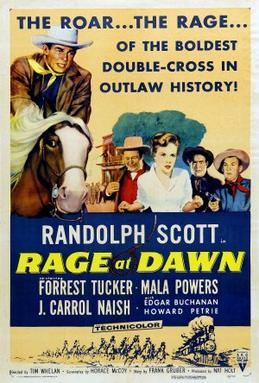It would be impossible in a Blog article to cover the 100's of Hollywood Motion Pictures dealing with before, during and after the American Civil War. So, I will take writers privilege and be selective in illustrating examples of these films. As much as possible I will compare the Hollywood version to the reality of the events they're portraying.
Many of Hollywood's films were made as pure entertainment, changing the facts, or just creating their own fiction. While others claimed to be an accurate representation of events, but contain racial stereotypes.
Below is a famous scene from 1939's "Gone with the Wind":
For my readers enjoyment I will divide this long article into sections with a topic displayed at the start of each.
JOHN BROWN AND HARPERS FERRY PRIOR TO THE WAR'S START
I am going to mention two motion pictures under this heading.
Santa Fe Trail (1940

This Hal Wallis production, directed by Michael Curtiz, with a screenplay by Robert Buckner, pretends to be the true story of John Brown's raid on Harper's Ferry. Why the picture was named "Santa Fe Trail" is never explained. As it has absolutely nothing to do with the trail established in 1821 to connect Independence, Missouri with Santa Fe, New Mexico.
Here is a selected list of the Historical characters and the actors who portrayed them.
Errol Flynn is cast as James 'Jeb" Stuart
Ronald Reagan is cast as George Armstrong Custer
David Bruce as Philip Sheridan
Moroni Brown as Robert E. Lee
Frank Wilcox as James Longstreet
George Hayward as John Bell Hood
William Marshall as George Pickett
Raymond Massey is cast as John Brown
Gene Reynolds as Jason Brown
Henry O'Neil as Cyrus Holliday
Erville Anderson as Jefferson Davis
You will note I never mention Errol Flynn's main co-star Olivia deHavilland.
_13.jpg)
The basic plot starts with life at West Point and the meeting of Stuart and Custer. After graduation the two newly made second lieutenants had for "Bloody Kansas" and their posting together at Fort Levanworth. Romance is added when the two men meet on a train Cyrus Holliday, the new Adjutant General of Kansas. Along with him is his daughter Kit Carson Holliday portrayed by Olivia deHavilland. Point of fact Holliday's daughter was named Lillie. In the picture his son is named Bob, but point of fact. Cyrus Holliday's son was Charles King Holliday.
This movie is filled with other errors.To start:
Jeb Stuart, George Custer and Phil Sheridan are shown as friends in the same West Point Class. Problem they weren't as Custer and Stuart never met. Looking at the year each graduated West Point also clearly shows the screenplays problem: Sheridan was 1853, Stuart was 1854 and Custer not until 1861.
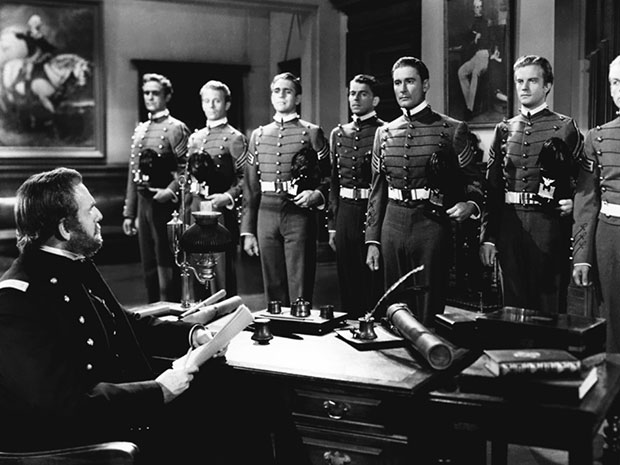
Two other factors changed for this "true" depictions of events:
Stuart served in the 1st Cavalry Regiment. While Custer was in both the 2nd and 5th Regiments and the small fact that George Armstrong Custer never served in Kansas at all.
As to the events surrounding taking John Brown at Harpers Ferry.
_NRFPT_01.jpg)
The picture has the Reverend White, a real person in the event, shoot and kill Brown's son Jason. Again in point of fact Jason was not killed in Kansas and White did kill one of Brown's other son's Frederick.
The motion picture has, as they used to call it, a "RIP ROARING" charge by the U.S. Cavalry with Jeb Stuart and George Custer in the lead. It never happened. There was no charge and the U.S. Army was not directly involved in the attack on John Brown's fort. It was taken by U.S. Marines by by the Union Army's Robert E. Lee.
The ending of the movie has Jeb Stuart marrying Kit Carson Holliday and the audience sees Jefferson Davis speaking of the future war. Somehow Custer comes to the conclusion that SLAVERY would never put the two friends at odds against each other, or cause the Southern States to leave the United States.
The Slaves that John Brown is attempting to rescue are presented in a stereo typical fashion. They talk of the "Good Life" they had back on the plantation and in a scene were some are trapped in a burning shed. They appear lost over what to do and would have burned to death, IF a white man hadn't appeared to lead them out of the fire.
One last falsehood. Jeb Stuart did marry, but the lady in question was Flora Cooke the commander's daughter at Fort Riley, Kansas in 1855. He was 22 and she was 19.
Seven Angry Men (1955)
Fifteen years after "Santa Fe Trail" a second motion picture was produced about John Brown and Raymond Massey returned in the role.

This film deals more with relationships within John Brown's family, or at least presents itself in that way. The supporting cast is interesting and included two actors were about to break into 1950's television in a big way as Brown's sons.
Jeffrey Hunter was cast as Owen Brown.
John Smith was cast as Frederick Brown,
James Best was cast as Jason Brown.
Dennis Weaver was cast as John Brown, Jr.
Guy Williams was cast as Salmon Brown.
Larry Pennell was cast as Oliver Brown
Tom Irish was cast as Watson Brown

The above picture is the Brown family as seen in this motion picture. Actress Ann Tyrell portrayed Raymond Massey's wife Mary Brown. This is one of the fictions is this account as John Brown's wife's name was Dianthe Lusk Brown. There are seven sons shown in the above picture. The films title "Seven Angry Men" refers to John Brown and his five eldest sons.
The plot of this motion picture revolves around a moral debate over Slavery and the killings the family was doing between John Brown and his third son Owen. Added to this story as a love interest for Jeffrey Hunter's Owen was actress Debra Paget as the fictitious Elizabeth Clark. From what I can determine Owen never married and actually joined the Union Army to fight against the Confederate States after Harper's Ferry.
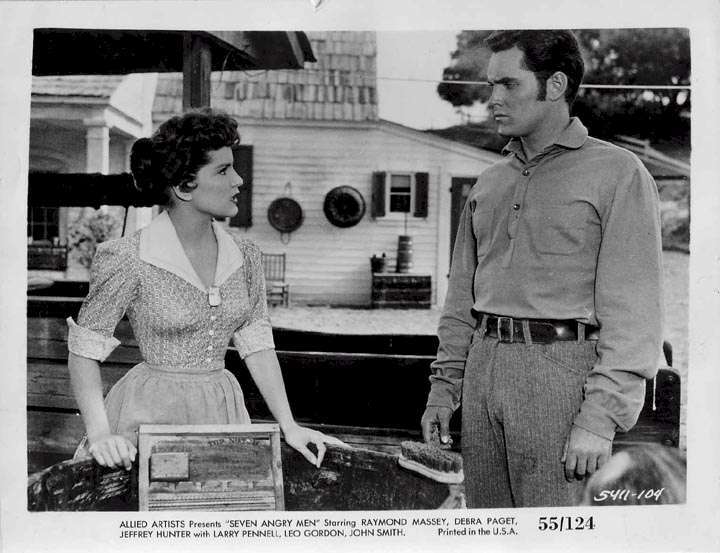
At this period in pre-Civil War History was a real group known as the "Border Ruffians". They were Pro-Slavery supporters from Missouri that raided into Kansas to attack any Free State/Abolitionist settlement. The "Ruffians" claimed to want Kansas kept neutral and not a haven for run away slaves as those for a "Free State" wanted. One of the real events is this motion picture has the "Border Ruffians" attacking Lawrence, Kansas on December 1, 1855. This is not the famous attack by "Quantrill's Raiders". According to the film Elizabeth Clark's father and four other men are killed in this attack. As a result John Brown declares that "The War Had Begun" and forms a militia.
Brown captures five men who are supposed to be members of the "Ruffians" and summarily executes them. This action sickens John, Jr. Jason makes a decision to turn the two of them over to the Army, because this is just one event making John, Jr. mentally unstable. Other events follow and Fredrick also leaves his father. Owen on the other hand stays.
At this time in the story John Brown's youngest son Watson now joins him and he seeks financial support in the North. Two of the major abolitionists who assist him are Ralph Waldo Emerson and Henry David Thoreau. A factual event interspersed with the fiction. This leads to purchasing weapons and Harpers Ferry. Owen is not there, but at a school house awaiting the arrival of escaping slaves. While the Army arrives at Harpers Ferry under the command of Lt. Colonel Robert E. Lee. Both Watson and Oliver Brown are killed and their father captured.
John Brown is put on trial and convicted. Prior to being hanged Owen and Elizabeth meet with him and he gives them his blessing.
Here are the actual events related to Harpers Ferry, Virgina. John Brown wanted to create a state in the union made up of freed slaves.
As he started to recruit followers for a major raid against Slave Owners. One of his main supporters was Harriet Tubman who helped Brown plan his attack. Tubman recruited for John Brown former slaves living in Ontario, Virginia.
Brown arrived at Harpers Ferry on July 3, 1859 to survey the area and rented a farmhouse in Maryland to await the arrival of his recruits. The plan called for 4,500 men, but Frederick Douglas, who opposed violence, was working against him and Tubman. When the actual attack occurred on October 16, 1859. John Brown had with him 21 men. Three were placed as a rear guard which including Owen. John Brown's raid on Harpers Ferry only consisted of 18 men.
John Brown had rounded up hostages from nearby towns. One of them was Colonel Lewis Washington the great-grandnephew of George Washington..
On October 18, 1859 United States Marines were sent by the Department of the Navy to free the hostages and capture John Brown. Overall command was not by a Naval, or Marine Officer, but Army Colonel Robert E. Lee. His second in command was Army Fist Lieutenant J.E.B. Stuart. Who under a flag of truce asked Brown to surrender to avoid bloodshed. John Brown refused and the Marines stormed the building capturing the abolitionist.
On December 2, 1859 at the age of 59 John Brown was hanged.
TWO EPIC CIVIL WAR MOTIONS PICTURES: ONE FROM THE POINT OF VIEW OF THE SOUTH AND THE OTHER FROM THE NORTH
Gone with the Wind (1939)
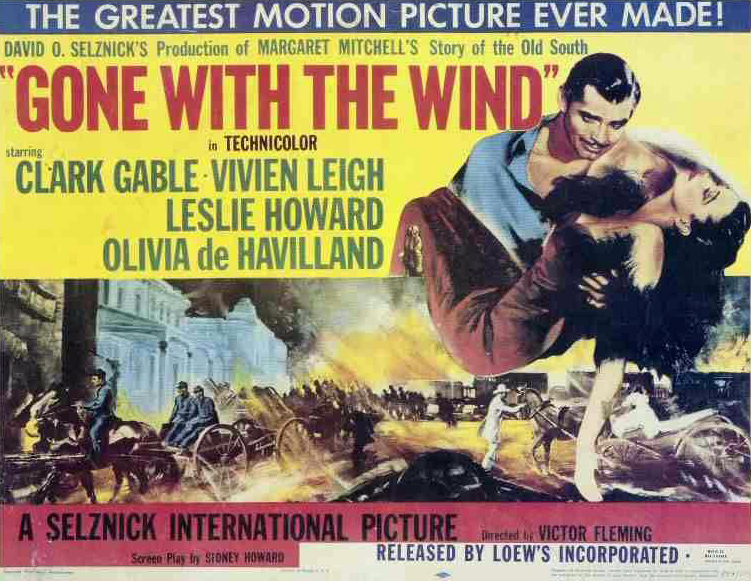
In 1936 Margaret Mitchell's novel was released. The novel covered the Civil War and the Reconstruction period through the eyes of her heroine Scarlett O'Hara. Today Mitchell's four leading characters, Scarlett O'Hara, Rhett Butler, Melanie Hamilton and Ashley Wilkes, have become stereo typed as has the motion picture. However, when the novel was first published and the movie first released. They were not considered that by White American audiences across the country and this fact held for decades. In fact the movie still has a strong audience appeal as does both DVD and Blu-Ray sales.
The motion picture as originally premiered ran 238 minutes. This included the Overture, Intermission, Entr' Acte Music and Exit Music. The actual length of the motion picture from opening credits to the end of the closing credits is 223 minutes. During this time the audience sees a picture of the Old South as Margaret Mitchell envisioned it and multiple directors brought to the screen. In short as a stylized, often described as a picture postcard of the South.
In his 2009 work "America, Empire of Liberty: A New History". British author David Reynolds wrote:
The white women are elegant, their menfolk noble or at least dashing. And in the background, the black slaves are mostly dutiful and content, clearly incapable of independent existence.

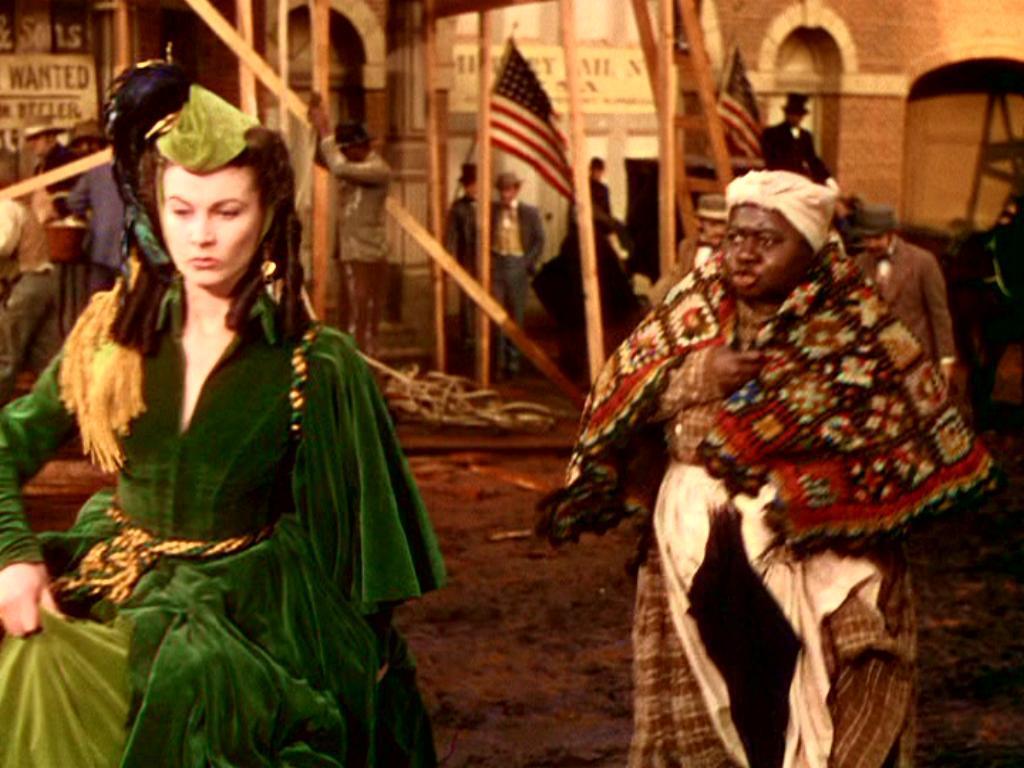
In their 2003 work "Screen Saviors: Hollywood's Fictions of Whiteness". Authors Hernan Vera and Andrew Mark Gordon make two short observations pertaining to the stereo types of the characters in David L. Selznick's "Gone with the Wind".
The two authors called the motion picture:
Social Propagandaand a
White Supremacist view of the pastProbably one of the most interesting stories pertaining to the finished motion picture revolves around African-American actress Hattie McDaniel who portrayed "Mammy". McDaniel is seen following Vivien Leigh as "Scarlet O'Hara" in the above still and will be mentioned again in this article
That story takes place at the 12th Academy Awards. When "Gone with the Wind" won eight of the thirteen Oscars it had been nominated for. One of those wins went to Hattie McDaniel for Best Supporting Actress. There were three other actresses nominated including Olivia de Havilland's performance as "Melanie Hamilton" in the film. The banquet for the awards was held, on February 29, 1940, at the prestigious Coconut Grove Restaurant of the Ambassador Hotel in Los Angeles, California.
Even in Los Angeles the Coconut Grove was racially segregated. As a result when it came time for Miss McDaniel to receive her Oscar which she had been notified of before hand. The African-American actress was brought into the banquet hall through the kitchen. Received her award, gave a beautiful acceptance speech and was escorted back out of the Grove through the same kitchen. She was not permitted to participate in any other activity with her fellow cast members, including the fine dinner, of the Academy of Motion Pictures Arts and Sciences.
Shortly after this took place Walter Francis White the head of the National Association for the Advancement of Colored People (NAACP) called Hattie McDaniel an:
Uncle TomAccording to the 2010 work "Frankly My Dear: Gone with the Wind: Revisited" by Molly Haskell. Hattie McDaniel called out Walter White on the grounds he didn't have the right to speak for "Blacks", because he was light skinned and only 1/8th Black.
Hollywood was stereo typing Negroes and at the same time demonstrating their own racism. None of Hattie McDaniel's co-actors spoke out on her behalf.
It took until 1957 for Hollywood to tell the other side of the Civil War in the same epic style as "Gone With the Wind".
Raintree County (1957)
Published in 1948 by Ross Lochridge, Jr was a novel starting prior to the Civil War in 1859, covering a portion of that war and what happens in the small county of "Raintree, Indiana" afterwards. The novel is massive with flashbacks within flashbacks. When it became a motion picture of the same name only a basic outline was used with a completely different happy ending. Unlike the very easy to follow year by year story found in "Gone with the Wind" the complex novel posed many problems for Hollywood.
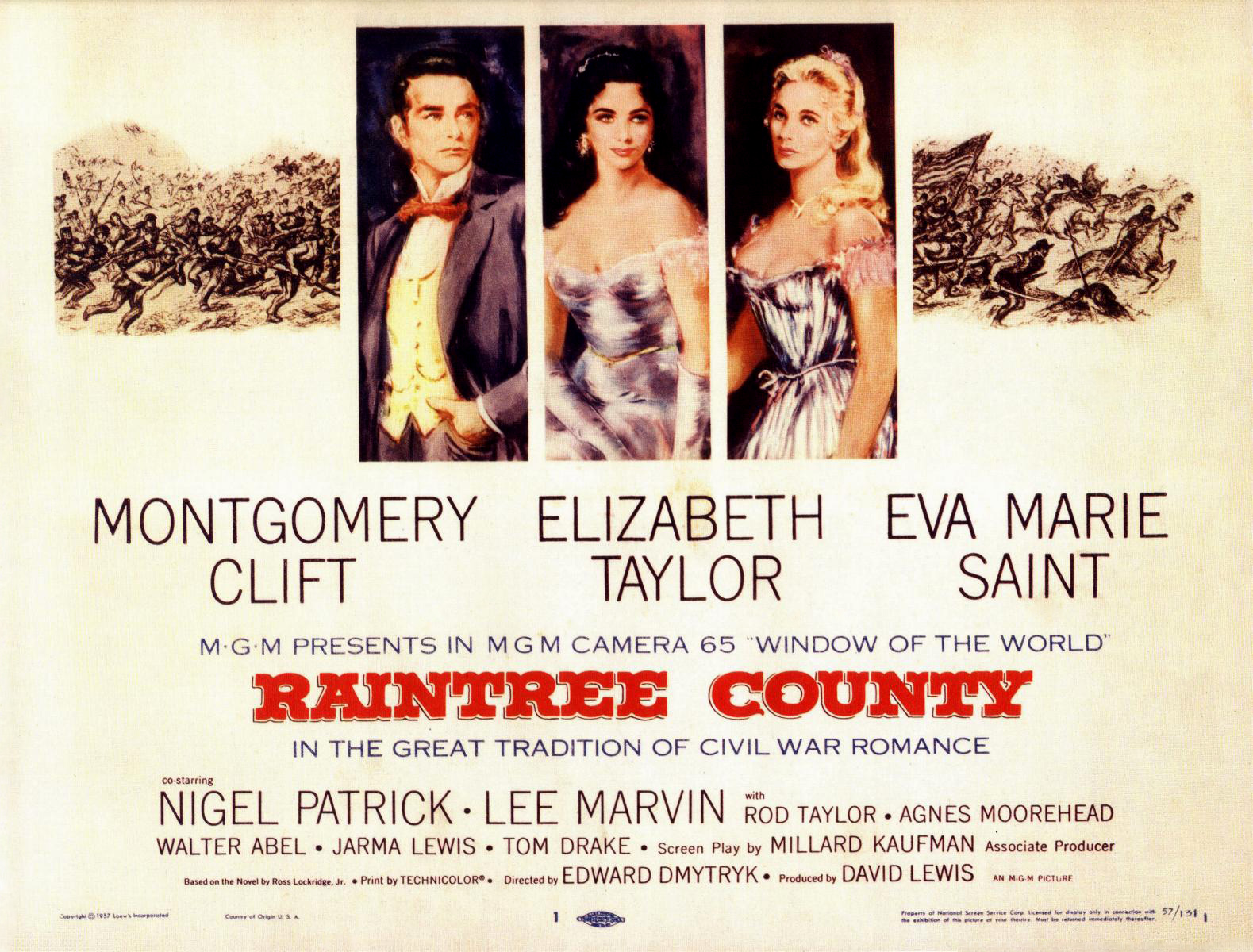
The motion picture had a running time of 182 minutes including Overture, Intermission, Entr' Acte Music and Exit Music. The actual running time of this film from opening credits through the ending was 164 minutes.
Metro-Goldwyn-Mayer planned this motion picture as a direct counter to "Gone With the Wind" and hoped it would have the same status as that other picture still retained. They were wrong and this Northern point of view of the Civil War period is all but forgotten by most.
The slave issue is addressed, as are Southern sympathies, through the character of Susana Drake portrayed by Best Actress nominee Elizabeth Taylor. Susana arrives in Raintree, Indiana with her slaves and will disrupt the lives of two people John Wickliff Shawnessey, Montgomery Clift, and his childhood girlfriend Nell Gather, Eva Marie Saint. Along with causing a discussion of slavery by many residents of the small community.
_01.jpg)

Susana tricks John into marriage and takes him to her family home in the South. There is a family secret and this will address a darker side of slavery in the Southern states. That of White male plantation owners having children with their Negro female slaves. When the Civil War breaks out the two are torn over the war and the slavery issue. John joins the Northern Army and serves with some of his hometown friends.
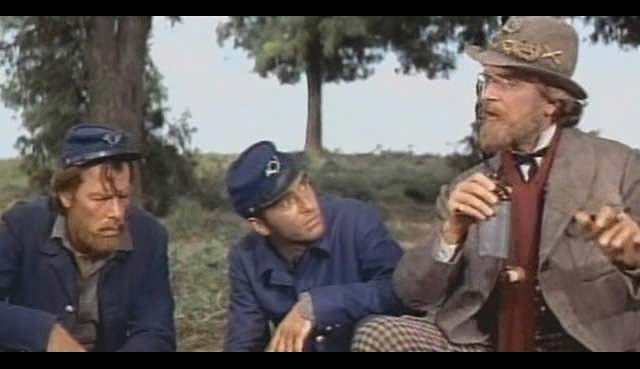
After the war the film turns more strongly to the idea that Susana believes she is the daughter of a white man and black slave. This will affect her mental stability and lead to the story's conclusion.
I wrote a biographical article about the short and tragic life of author Ross Lockridge, Jr and the making of this motion picture. Both stories are very interesting to film buffs. Including how a car accident to Montgomery Clift almost paralleled what happened to James Dean making another film starring Elizabeth Taylor "Giant". For those interested my article can be found at
http://www.bewaretheblog.com/2017/02/the-making-of-motion-picture-version-of.html
THREE HOLLYWOOD MUSICALS SET DURING THE CIVIL WAR ERA
As I have already mentioned stereo types of slaves during the Civil War appeared in many motion pictures and the two I want to mention next might be overlooked in this respect, because of there star.
The first title is "The Littlest Rebel" released November 25, 1935 and starred "America's Sweetheart" seven year old Shirley Temple and featured Bill "Bojangles" Robinson. The most highly paid African-American dancer/actor during the first half of the 20th Century. He was also the first African-American dancer to appear as part of an interracial dance team with Shirley Temple in "The Little Colonel" released February 22, 1935.
_05.jpg)
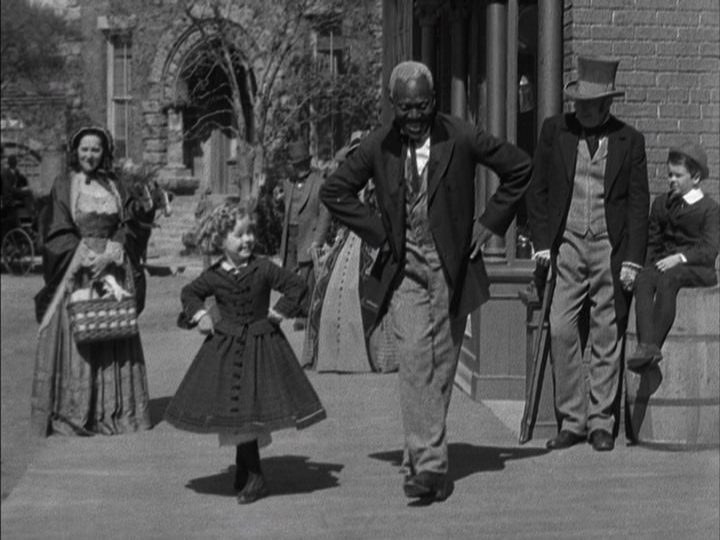
Both motion pictures portrayed southern slaves as very happy with their lot. Of course these were Shirley Temple vehicles and the song and dance routines, as seen above, are very well done. In "The Littlest Rebel" Shirley portrayed Virgie the daughter of a man who becomes a Confederate scout and will be captured. Bill Robinson portrays a loving family slave referred too as Uncle Billy. There is a very brutal Union Sergeant, named Dudley, who leads a group that loot and vandalize the plantation house.Temple meets Abraham Lincoln and pleads her case to save her father from death. The President grants it and the film ends with Shirley Temple singing "Polly Wolly Doodle".
In the comedy/drama "The Little Colonel". Lionel Barrymore is an ex-Confederate Colonel during reconstruction whose daughter marries a Northerner and is disowned by him. Shirley Temple plays the couples daughter Lloyd, also the Colonel's first name, who will be the means after some dramatic moments of reuniting the family.
Hattie McDaniel was seen as Becky "Mom Beck" Porter the housekeeper of the Colonel's daughter. Bill Robinson portrayed Walker the Colonel's butler.

The picture is primarily remembered and known for that first interracial dance number performed on stairs by Temple and Robinson. The number was cut out of the film for release in the South and in some areas both pictures were banned. Although Shirley Temple was very popular in the southern states.

Staying with a musical setting was a look at a Civil War Era American composer. On December 30, 1939 the Hollywood version of the life of composer Stephen Collins Foster was released entitled "Swanee River". The basic plot has Pittsburgh, Pennsylvania born Foster becoming a song writer, against the wishes of his parents, falling in love with the South and "It's simple people" Then meeting and marrying a "southern belle" named Jane McDowell. When the Civil War breaks out he is branded a traitor to the Union, because of the music he has written. He takes to drinking heavily, his wife leaves him, but two years later returns to encourage him to write "Old Folks At Home (Swanee River)". However, Stephen Foster dies of a heart attack on the night Edwin P. Christy of "Christy's Minstrels" is to perform that song to a New York City audience. The film ends with the audience being told of his death and Stephen Foster being recognized in the North once more for his music.

Don Ameche was cast as Stephen Foster, Andrea Leeds as Jane McDowell Foster.
Portraying the real life Minstrel Show /performer/owner Edwin P. Christy was Al Jolson. Seen below is "Blackface" make-up.
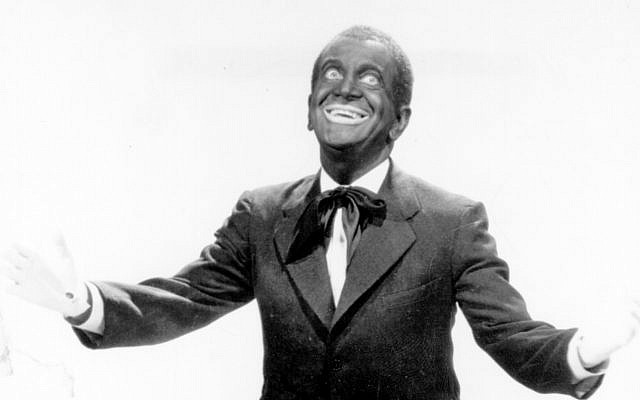
Minstrel shows featured White performers in "Blackface" speaking in a stereo typical Negro voice. During the 19th Century these shows were extremely popular and E.P. Christy was one of the biggest names in the North. It should be noted that there were also all African-American Minstrel shows that toured at this time under the direction of White owners.
In an article by Ken Padgett on September 20, 2014 entitled "Blackface! The Minstrel Shows". Frederick Douglas was quoted as saying these White Ministrel performers were:
The filthy scum of white society,who had stolen from us a complexion denied them by nature, in which to make money, and pander to the corrupt taste of their white fellow citizens.A little reality check on the life of Stephen Collins Foster is due to my reader. To begin with Jane McDowell was born in Pittsburgh as Foster had been. There was no way E.P. Christy could have been able to sing "Swanee River" in New York at the end of the movie. Simple reason he had committed suicide by jumping out of a window in his New York house in May 1862. As for the actual death of Stephen Collins Foster. On January 10, 1864 he became ill with a fever and fell in his room in a hotel. His writing partner George Cooper found Foster lying in a pool of blood with his neck cut. Three days later in Bellevue Hospital he died from his injury.
As to his being called a traitor in the North. In response to a call from President Abraham Lincoln for volunteers. Stephen Foster set the poem "We Are Coming, Father Abra'am" to music. The last four years of his life had been spent in New York and prior to that he lived in either Pennsylvania, or Ohio. Apparently he never once visited any of the Southern States.
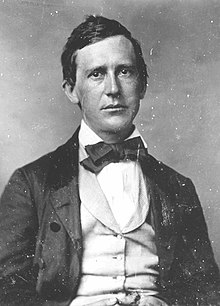
Above Stephen Collins Foster and among his songs are: "On Susanna!", "Jeannie with the Light Brown Hair", "De Camptown Races", "Beautiful Dreamer", "My Old Kentucky Home" and "Old Dog Tray".
HOLLYWOOD AND WILLIAM CLARKE QUANTRILL
William Clarke Quantrill's name may be forgotten to some, but names of some of his followers are not. They included Jesse and Frank James, Cole Younger and William T. "Bloody Bill" Anderson.
One of the first Hollywood versions of his story was called "Dark Command" released April 15, 1940 from Republic Pictures and directed by Raul Walsh.
From a strictly Hollywood point of view this motion picture had a very interesting cast of actors including a future "King of the Cowboys". Portraying William "Will" Cantrell, not "Quantrill" was Walter Pidgeon. Playing the women he married Mary McCloud was Claire Trevor and portraying her idealistic brother Fletcher was Roy Rodgers. In the role of Mary's one time Union suitor Bob Seton was John Wayne/ While the roles of Andrew "Doc" Grunch went to George "Gabby" Hayes and Cantrell's over protective mother to Marjorie Main.

This story was based upon a novel and is far from the truth, but very entertaining hokum. After Mary weds Will Cantrell she discovers his dark secret, In reality this school teacher is the leader of a gang that attacks both the North and the South for profit. Cantrell and his men capture a wagon train full of Confederate Uniforms and he decides to use them to turn his men into Southern Troops. Fletcher admires Will whom he thinks is a real Confederate Officer and joins up with him. Realizing later what is actually happening. After Bob Seton is captured by Cantrell and is to be executed as a spy. Fletcher with Mary's help rescue him. The three head out to warn the citizens of Lawrence, Kansas that Cantrell and his men are coming. It is during that attack that both William Cantrell and his mother are killed.

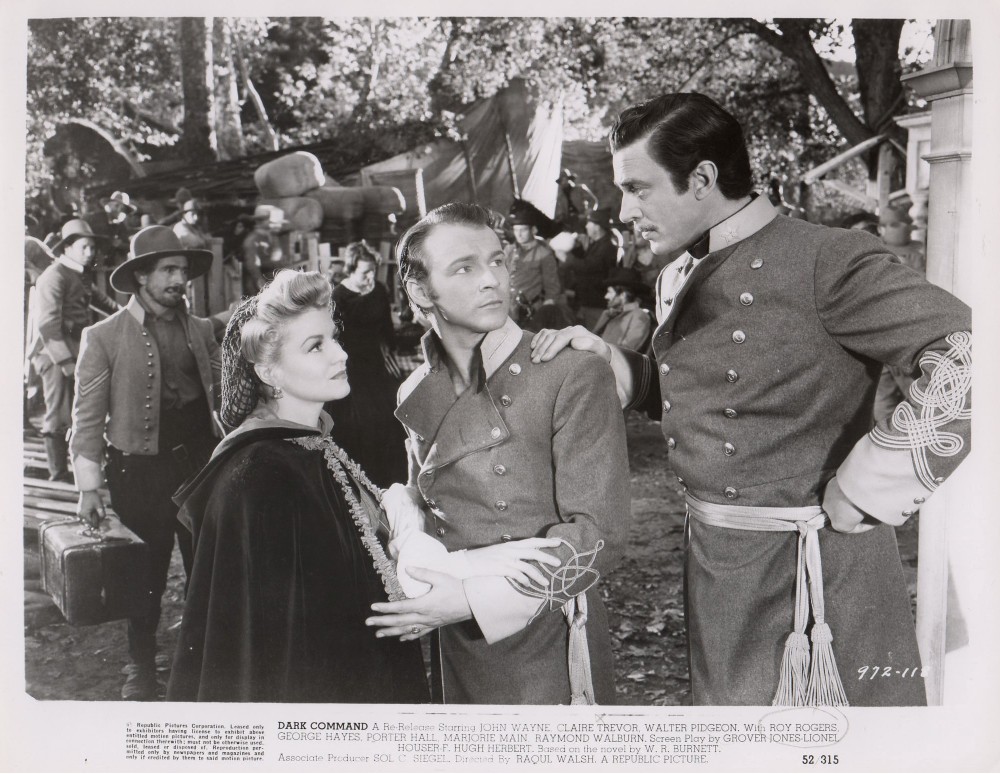
In 1950 Universal Pictures released their version of the story of William Clarke Quantrill entitled "Kansas Raiders".

Universal Studios had some interesting future major names in their stock company. Along with some other's that were solid "B" actors. The cast of this version of Qunatrill's story were a who's who of 1950's Hollywood.
In his sixth movie role since 1948. The picture starred the most decorated soldier of World War 2 Audie Murphy as Jesse James. Murphy had just played Billy the Kid in another picture. Solid 1940's actor Brain Donlevy was William Clarke Quantrill. Scott Brady was William T. "Bloody" Anderson, Tony Curtis was Kit Dalton, Richard Long was Frank James and James Best was Cole Younger. As a Union Officer was Richard Arlen. Arlen had co-starred in the first Best Picture Oscar Winner the silent classic "Wings" and the 1932 H.G. Wells "Island of Lost Souls".

Jesse, Frank and their friends ride into Lawrence, Kansas and are accused by the citizens of being part of Quantrill's raiders. At this time they are not and with the help of a Union Officer are released prior to being hanged. The group do end up in Quantrill's camp were Jesse becomes his right hand man.
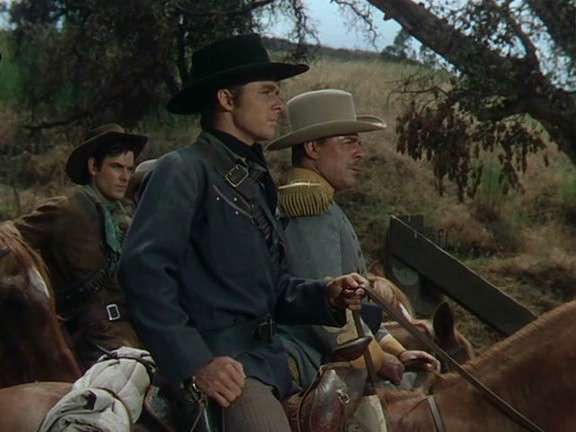
After executing some captured Union soldiers without following the articles of war. Kate Clarke, Margurete Chapman, Quantrill's ex-lover, accuses him of becoming a murderer and not a Confederate soldier. The good Jesse James wants to leave, but Quantrill convinces him to stay. He promises not to kill innocent people anymore, but next comes the Lawrence, Kansas Massacre. Quantrill is killed and Jesse rides out to become a legendary outlaw.
Quantrill's Raiders (1958)
Just eight years later another version of William Clarke Quantrill was released. In this film without mentioning Jesse and Frank James, or the other famous outlaws the rode with Quantrill. He was portrayed by actor Leo Gordon.
Union Captain Alan "Wes" Wescott, Steve Cochran, goes undercover as Michael Davis to get Quantrill. Below Cochran on left with Myron Healy as Jarrett.

There is the typical love story with a girl named Sue, Diane Brewster, and the raid on Lawrence were Quantrill is killed. The entire plot other than naming Quantrill and having the Lawrence raid is fictional.
Who was the real William Clarke Quantrill?

I pick up his story in 1858 when he was a teamster on a Union Army expedition to Salt Lake City, Utah. Shortly afterwards he is became part of a group of Missouri "Border Ruffians" attacking those who wanted to make Kansas a free slave state such as John Brown's original settlement. Yet, by 1859 he was a school teacher, his actual background, in Lawrence, Kansas. This lasted for a year when the school was closed. From a letter to his mother it is known that he had become a solid pro-slavery supporter.
In 1861 Quantrill went with a slaveholder into the Cherokee Nation. He spent some time with the Indians and learned their style of fighting, or what in war would be known as "Guerrilla Tactics". It was this Cherokee style of fighting that Quantrill would teach his raiders.
With the outbreak of the Civil War William Quantrill joined the Confederate army under General Sterling Price.

Qunatrill fought in both the Battle of Wilson Creek and one at Lexington both between August and September 1861. Being a Confederate soldier under Price was not to his taste and he deserted the army to form his own. By December of 1861 William Clarke Quantrill's private Confederate army consisted of ten men. The following year he had been joined by the James Brothers, Cole Younger and William T. "Bloody Bill" Anderson.
The raid of Lawrence, Kansas is the most famous, or infamous event in the life of William Clarke Quantrill. The motivation for this attack was the town's long history of supporting the freeing of slaves. It had earned Kansas the nickname of "Bleeding Kansas".
How many were in "Quantrill's Raders" varies by account as between 400 to 450. When the slaughter was over Quantrill had lost 40 men, but the town of Lawrence, Kansas had lost 164. Hollywood, as mentioned above, had a habit of making great movie endings and had William Clarke Quantrill killed during the raid. Actually he lived.
The Union army under General Thomas Ewing, Jr, pursued Quantril and his men.

They escaped into Texas and it was there that the group finally broke up. In 1864 William Quantrill rejoined "Bloody Bill" Anderson's group for a short time. In the spring of 1865 Quantrill's band of 12 men were raiding in Kentucky. On April 9th General Robert E. Lee surrendered, on April 25th General Johnson surrendered the rest of the Confederate army. On May 10, 1865 William Quantrill and his men were caught in a Union ambush and brought to Louisville, Kentucky. On June 6, 1865 in prison William Clarke Quantrill died at the age of 27 from wounds received in the ambush.
JOHN HUSTON, SAM PECKINPAH AND JOHN FORD ON THE CIVIL WAR
In 1895 American author Stephen Crane wrote a masterpiece about the Civil War. On March 16, 1951 MGM released the John Huston directed motion picture. As with most of his works Huston also wrote the screenplay for "The Red Badge of Courage".
Audie Murphy was cast as Henry Fleming aka: "The Youth". Henry is filled with dreams of glory. Only to have the realities of war overtake him. Which is the basic plot of Crane's novel and delivered by Murphy remembering his own experiences in World War 2.
Bill Mauldin was cast as Tom Wilson aka: "The Loud Soldier". Yes, this was the same World War 2 political cartoonist who won two Pulitzer Prizes for his work. Below Mauldin is to the right of Murphy.

Three other character actors of note were seen in this feature. Royal Dano was "The Tattered Man", Arthur Hunnicutt was Bill Porter and Andy Devine portrayed "The Cheery Soldier".
In some ways this is a Civil War Film Noir from the way Huston shot his picture, but that technique helped him capture the characters of Crane's words. The original director's cut was 120 minutes, but had poor preview screening and MGM cut the film down to 70 minutes. The other 50 minutes of John Huston's original cut are lost. Both Huston and Audie Murphy attempted to purchase the footage to return the picture to its original version without success.
When you think of the Civil War most people talk about battles such as Shiloh, Little Round Top and of course Gettysburg. Overlooked by most is that the Civil War was not just in the East and South of the Country, but the West also. In 1965 Sam Peckinpah directed Charlton Heston, Richard Harris, James Colburn and Michael Anderson, Jr. in "Major Dundee".

The initial setting of the motion picture is the New Mexico Territory. Major Amos Charles Dundee, Charlton Heston, is in command of a Union military prison for captured Confederate soldiers. One of those is Captain Benjamin Tyreen, Richard Harris.
Through the dialogue between the two men we learn that they were boyhood friends and Amos Dundee is a Southerner who choose to stay with the Union. This creates animosity between the two mean over Dundee's abandonment of "His Country".
There is an Apache raid lead by Sierra Charriba, Australian actor Michael Pate, on a homestead and everyone is killed but the young boys. They have been taken by Charriba to turn into Apache warriors. Major Dundee sees a chance for glory first and a means of restoring his name. Apparently at Gettysburg he disobeyed orders.
Michael Pate as Sierra Charriba is to the left in the following photo. You may recognize him as "Vittorio", the Apache chief, in the John Wayne film "Hondo". My article on this interesting character actor and another Woody Strode may be found at:
http://www.bewaretheblog.com/search?updated-max=2015-03-23T12:47:00-07:00&max-results=7&start=1&by-date=false
.png)
Dundee sends scout Samuel Potts, James Coburn, out to find the Apaches and report back to him wherever he may be.
.png)
The problem for Major Amos Dundee is that he doesn't have enough troops to pursue the Apaches and guard the Confederate prisoners. This results in a deal with Captain Tyreen to be second in command of this "rescue" mission and the need for a small number of prisoners to accompany him.
Looking for Union volunteers brings Sam Peckinpah to another interesting and at time overlooked chapter of Civil War history. Asking Dundee to let him go on this mission is African-American actor Brock Peters as Aesop. He requests that he and the other six "Coloreds" have a chance to fight. This will lead to some interesting exchanges between the Southern soldiers and the "Buffalo Soldiers" on race.
There is an incident between one of the Southerners and Aesop about taking off the Confederate's boots. The Confederate looks upon the proud "Buffalo Soldier" as still a slave and his words speak to that. Acting Lieutenant Tyreen steps up and stops it as tension builds and apologizes to Aesop and his "Colored" Soldiers. He even compliments them on how they are handling themselves. It is obvious this is hard for Tyreen to say.
Playing one of the Southern soldiers was Ben Johnson as Sergeant Chillium. Johnson of course appeared in both John Ford's "She Wore a Yellow Ribbon" and "Rio Grande" as an ex-Confederate Officer now just Sergeant Tyree in the Union Army.

Another factor in this film that is brought up has to do with Mexico at the time of the American Civil War. While as I mentioned there are many Civil War motion pictures. Only the Andrew V. McLaglen directed "The Undefeated" from years later starring John Wayne and Rock Hudson and this picture. Speak to the fact that Austrian Maximilian was ruling the country as Emperor for Napoleon the Third. At one point Major Dundee's troops cross into the country. illegally chasing the Apaches, and have to fight French troops.
Anyone seeing this picture, as I did, when it first came out. Knew that there was something missing. According to sources the original director's cut of this Civil War epic ran Four Hours and Thirty-Eight minutes in length. For the themes and events covered I can believe that.
However, when it was originally released by Columbia Pictures. The picture ran two hours and three minutes. In 2005 a "Restored version" was released to limited theaters and on DVD which I have. This version runs two hours and sixteen minutes in length. This restoration contains found deleted scenes and is the cut producer Jerry Bresler had originally suggested for theatrical release. However, initially when asked to re-edit his motion picture by Columbia Studios. Sam Peckinpah made a two hour and thirty-two minute cut.
Released June 12, 1959 from director John Ford was "The Horse Soldiers". The screenplay was loosely based upon Harold Sinclair's 1956 novel. Which in turn was loosely based upon the real Civil War raid of Colonel Benjamin Grierson. In short real history turned into a novel and then the novel reworked into a screenplay.

John Wayne plays Colonel John Marlowe, a builder of railroads, given the mission of destroying Confederate railroad equipment at Newton Station, Mississippi. Then he's to continue south to New Orleans, Louisana held by the Union to be put on outgoing Naval vessels to return to LaGrange, Tennessee. The point where his mission began.
Marlowe first has to deal with his own prejudice toward doctors. When he has to take a two man medical unit with Doctor Major Henry "Hank" Kendall portrayed by William Holden.

On Colonel Marlowe's march south he stops at whats left of a plantation owned by Miss Hannah Hunter, Constance Towers. There will develop a slow building love between the two.
Portraying Hannah's maid Lukey was Athea Gibson not a professional actor, but a professional golfer and tennis player. She was the first person of Color to win a profession tennis title. In 1956 this was the French Open and the following year she won both Wimbledon and the U.S. Nationals that later became the U.S. Open.
Lukey is presented in some ways as an equal to Hannah.
There's an interesting sequence when to stop Marlowe's advance a Military school is sent out to fight the Union soldiers. Of course Marlowe calls a retreat to avoid injuring these boys. This however was a tactic used by the Confederate army at times.

The film is full of exciting battle action you expect in a John Ford motion picture. When Marlowe's troops arrive at Newton Station and begin to dismantle the railroad. Reports of an unscheduled train approaching leads to immediate defenses being put up and box cars opening filled with Confederate troops. An all out battle on the streets of the town of Newton Station comnences. Afterwards as Marlowe and his troops head south towards New Orleans. They are now pursued by Confederate Calvary leading to the climatic encounter between the North and the South. In the end William Holden's doctor has to remain with the wounded knowing he will probably end up in Andersonville Prison. Marlowe promises Hannah he will return after the war. blows up a bridge and escapes with the remaining troopers towards New Orleans.
His name wasn't John Marlowe, but Benjamin Henry Grierson.
He wasn't a Railroad Construction Engineer, but a Music Teacher. The raid consisted of 1,700 Calvary troopers that would start at LaGrange, Tennessee and end not in New Orleans, but Baton Rouge, Louisiana. Some of his men wore actual Confederate army uniforms to act as both scouts and spy's. The raid started on April 17, 1863 and ended on May 2, 1863 in Baton Rouge.
Unlike "The Horse Soldiers" the real raid wasn't aimed just at Newton Station, but any destruction they could commit to the Southern Railway System. The Union troops destroyed railroad ties as they traveled south and locomotives. They freed slaves, burned Confederate store houses, destroyed or commandeered Confederate commissary stores, tore down bridges, destroyed trestles, burned buildings and whole towns. Unlike John Ford's motion picture once Grierson's troops reached Baton Rogue. His losses were three killed, seven wounded and nine missing, or a total of 19 out of his original 1,700.
Benjamin Grierson married Alice Kirk on September 24, 1854. She was not from the south as the fictional Hannah Hunter, but was born in Youngstown, Ohio.
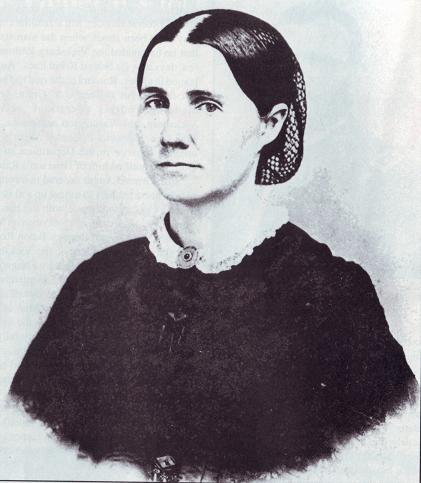
On April 12, 1862, one year and five days, prior to the Grierson raid was another led by James J, Andrews with only 23 other men. The result of this raid was the awarding of the first ever Congressional Medals of Honor. One of the participants of the raid and awarded the Congressional Medal of Honor was William Pittenger. Pittenger wrote and published an account of the action. The title of his account forever renamed it from the official Army designation "The Andrews Raid" to "The Great Locomotive Chase". My article on the Walt Disney motion picture starring Fess Parker and Jeffrey Hunter and the actual events can be read at:
http://www.bewaretheblog.com/2017/08/the-andrews-civil-war-raid-great.html
GLORY
I mentioned above how director Sam Peckinpah's 1965 film "Major Dundee gave it's audience a small view into the fact that African-American soldiers served in the Union Army during the Civil War. Two other motion pictures in the same decade mentioned their experiences after the war ended. The earliest was 1960's "Sergeant Rutledge" directed by John Ford.
Set in 1881 the story revolves around the court-martial of the title character accused of raping and murdering a white girl. This motion picture starred Jeffrey Hunter as First Lieutenant Tom Cantrell, Constance Towers as Mary Beecher, Billie Burke, best known as "Glinda, the Good Witch" of 1939's "The Wizard of Oz", as Mrs Cornelia Fosgate and Woody Strode as First Sergeant Braxton Rutledge.
Director Ralph Nelson made a hard hitting 1966 motion picture revolving around interracial marriage between a white man and a Native American women "Duel at Diablo". The film starred James Garner as Jess Remsberg the Calvary Scout whose Native American wife was raped, murdered and scalped by an unknown white man. Sidney Poitier portrayed Toller an ex-Negro Sergeant of the Union Calvary now a gambler. Both men will become involved with a glory hunting officer Lieutenant Scotty McAllister, Bill Travis, as he chases an Apache chief named Chata, John Hoyt, and his renegades.
As to the experiences of an African-American man at the time. The role of Toller could actually have been played by any ethnic actor as there is never a mention of Poitier's race in the picture.
It wouldn't be until 1989 that the experience of an ex-slave in the Union army was truly looked at in "Glory" directed by Edward Zwick. As strange as this may seem to many of my readers. Most American's, in 1989, had no idea that African-American's ever served in the military during the Civil War. They just pictured them as slaves and this misconception was also prevalent in the African-American community itself.
The motion picture was based upon a novel "One Gallant Rush: Robert Gould Shaw and His Brave Black Regiment" by Peter Buchard, Along with "Lay This Laurel" by Lincoln Kirstein and Robert Benson and Robert Gould Shaw's own letters.
Injured at the battle of Antietum Captain Robert Gould Shaw, Matthew Broderick, returns home to Boston, Massachusetts. White Shaw is offered a promotion to Colonel, IF he will accept command of the "54th Regiment Massachusetts Volunteer Army". Any officer would immediately except the promotion, BUT this is an all Black Regiment and prejudice has stopped all other's offered the command. Robert Shaw is literally the last officer asked.
His second in command is Major Cabot Forbes portrayed by actor Gary Elwes. Broderick is in foreground of the following photo and Elwes is to the far right.
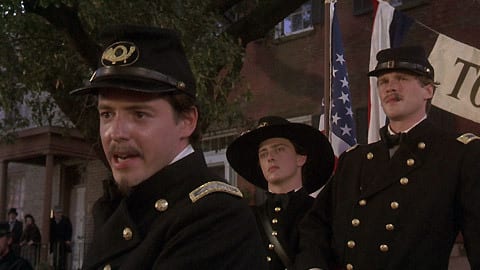
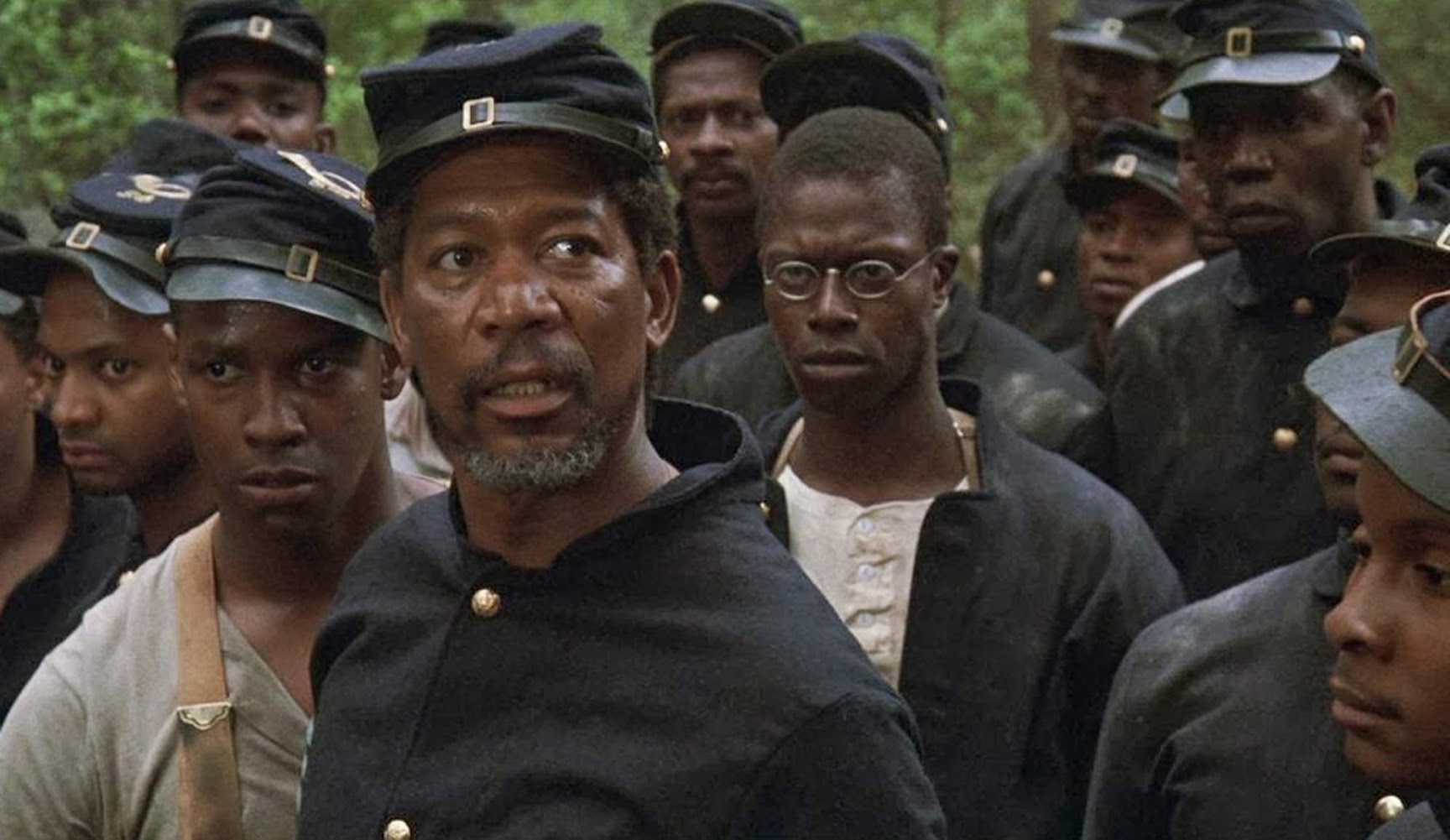
Portraying the three main soldiers were African-American actors Morgan Freeman, center, as Sergeant Major John Rawlins, Denzel Washington, to Freeman's left, as Private Silas Tripp and Andre Braugher, to Freeman's right, as Corporeal Thomas Searles.
The motion picture goes into not only the problems facing Robert Shaw, but the differences of education and position of the escaped slaves. One example is Thomas Searles who was a friend of Shaw, in this film, and highly educated for a man of Color of the time. He has major problems of acceptance into the regiment by the other men and has never in his life known the slave experience.
Shaw is up against a Union Army system run by White's. Who even though they are "Fighting to Free the Slaves" are as racially prejudiced as the Southerners they are at war with. After a very long period of training and fighting the Union Army bureaucracy. Colonel Robert Gould Shaw has as strong a Regiment as any other officer.
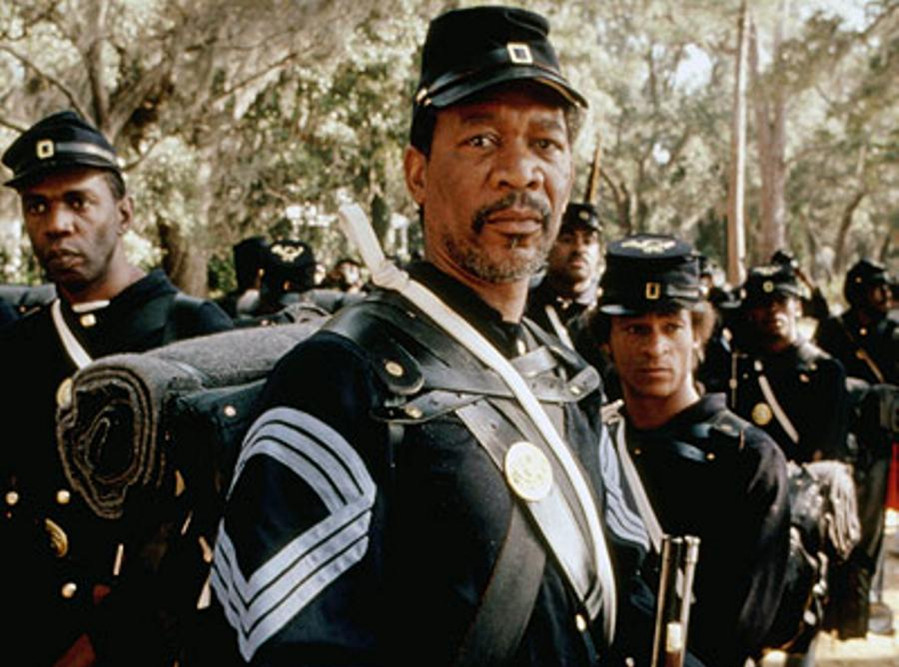
The Color of the "54th Regiment's" skin again comes into play. Although they're at the front lines in South Carolina. The White Officer's in command believe they are Freed Slaves playing at being soldiers.
However, White troops are dying and not taking the objective of Fort Wagner in Charleston Harbor. The only approach is from the front as the back of the Fort faces the water. At this point Shaw volunteers his Regiment to lead the final charge to take Wagner and his men go into "GLORY" fighting and dying, but taking the Fort.
The real Robert Gould Shaw entered the Civil War as a private in the New York Militia on April 19, 1861. On May 28, 1861 he was formally commissioned a Second Lieutenant in the 2nd Massachusetts Infantry. In late 1862 his father brought up the idea of taking command of an all black regiment. From pressure by his father and others he accepted the command. Although Shaw wasn't really sure a black regiment made mostly of escaped slaves would work.
Robert Shaw realized the dedication of his men and came to respect them. On March 31, 1863 he was promoted to Major and on April 17th to Colonel. His regiment went into Georgia to fight and on June 11, 1863 Shaw wrote home of what he considered abuse by the Union Army. His letter told of shells being fired over the city of Darien that was full of nothing but women, children and elderly men. Colonel Shaw told of their possessions being looted and the town burned to the ground. This appalled him and his men.
Robert Shaw had been ordered by his commanding officer Colonel James Montgomery to burn the town and had refused. It should be noted that Darien had been founded by Scottish immigrants who signed the first petition in Georgia against slavery and most of their descendants made up the population.
The 54th Regiment was than sent to Charleston, South Carolina to take part in operations against the Confederates in that State. On July 18, 1863 the 54th and two white brigades assaulted Confederate "Battery Wagner" referred too as a Fort, because of the position of this re-enforced gun battery. The combined unit hesitated, because of fierce fire from the battery. A short time later Robert Gould Shaw was heard to state:
Coming on the scene Confederate General Johnson Hagwood had the bodies of the Union Officers dug up and returned to their lines. He left the body of Robert Gould Shaw where it was and is quoted by witnesses as saying:
THE RENO BROTHERS
Mention Renegades and Outlaws during the Civil War. The odds on favorite reply would be Frank and Jesse James. As of 2007 with the motion picture "The Assassination of Jesse James By the Coward Robert Ford". There have been 48 motion pictures specifically about the brothers starting with 1908's "The James Boys of Missouri". The Hollywood actors who have portrayed the brothers over the years include Tyrone Power and Henry Fonda, Robert Wagner and Jeffrey Hunter, John Pierce and Robert Duvall, Stacy and James Keach and even Kris Kristofferson and Johnny Cash.
Mention the Reno Brothers and probably nobody, but a Civil War expert might even know whom I'm speaking about. Yet Hollywood made two motion pictures about them in the 1950's and one was the film introduction of a major singing sensation.
Rage at Dawn (1955)
In this RKO production set in Indiana. Forest Tucker is Frank Reno, J. Carrol Naish is Simeon "Slim" Reno, Myron Healey is John Reno and Richard Garland is Bill Reno. All four are outlaws and two had served in the Confederate Army. Which the audience is told has hardened their attitude toward violence. The fifth brother Clint Reno is a very respected Indiana farmer portrayed by Denver Pyle. Their sister Laura, Mala Powers, who has inherited the family home, serves as cook and housekeeper for her four bad brothers.
When the brothers go to rob a bank in a nearby town. The people are ready for them and Bill is killed. The other three suspect somebody they know tipped off the authorities. The local bartender is killed as the informant, but the Reno Brother's don't know he was working for the Peterson Detective Agency.
Enter Randolph Scott as James Barlow out to get the Reno's. To get in with the brothers Barlow robs a train that was set up to make him look good. In his undercover persona Barlow and Laura fall in love.
This will all lead to a another set up train robbery and the capture of the three brothers. However, mob violence takes over and they're all hung. Previously James Barlow attempted to stop the towns people and this action ends Laura's misgivings of him and the audience is given the impression the two will marry.
There were a couple of noticeable mistakes seen by the audience. Instead of filming in Indiana the producers used Columbia State Historic Park in California. The Park has a great looking period town used by many productions. In one scene of the gang riding into the town to rob a bank. The audience sees power poles and electric lines. As the Reno's pass a post office, It is flying the current American flag, which is OK, but also clearly shown is the California State flag.
The following year 20th Fox released their version of the Reno Brothers. In "Rage at Dawn" Clint Reno looked like actor Denver Pyle:
Unlike "The Horse Soldiers" the real raid wasn't aimed just at Newton Station, but any destruction they could commit to the Southern Railway System. The Union troops destroyed railroad ties as they traveled south and locomotives. They freed slaves, burned Confederate store houses, destroyed or commandeered Confederate commissary stores, tore down bridges, destroyed trestles, burned buildings and whole towns. Unlike John Ford's motion picture once Grierson's troops reached Baton Rogue. His losses were three killed, seven wounded and nine missing, or a total of 19 out of his original 1,700.
Benjamin Grierson married Alice Kirk on September 24, 1854. She was not from the south as the fictional Hannah Hunter, but was born in Youngstown, Ohio.

On April 12, 1862, one year and five days, prior to the Grierson raid was another led by James J, Andrews with only 23 other men. The result of this raid was the awarding of the first ever Congressional Medals of Honor. One of the participants of the raid and awarded the Congressional Medal of Honor was William Pittenger. Pittenger wrote and published an account of the action. The title of his account forever renamed it from the official Army designation "The Andrews Raid" to "The Great Locomotive Chase". My article on the Walt Disney motion picture starring Fess Parker and Jeffrey Hunter and the actual events can be read at:
http://www.bewaretheblog.com/2017/08/the-andrews-civil-war-raid-great.html
GLORY
I mentioned above how director Sam Peckinpah's 1965 film "Major Dundee gave it's audience a small view into the fact that African-American soldiers served in the Union Army during the Civil War. Two other motion pictures in the same decade mentioned their experiences after the war ended. The earliest was 1960's "Sergeant Rutledge" directed by John Ford.
Set in 1881 the story revolves around the court-martial of the title character accused of raping and murdering a white girl. This motion picture starred Jeffrey Hunter as First Lieutenant Tom Cantrell, Constance Towers as Mary Beecher, Billie Burke, best known as "Glinda, the Good Witch" of 1939's "The Wizard of Oz", as Mrs Cornelia Fosgate and Woody Strode as First Sergeant Braxton Rutledge.
Director Ralph Nelson made a hard hitting 1966 motion picture revolving around interracial marriage between a white man and a Native American women "Duel at Diablo". The film starred James Garner as Jess Remsberg the Calvary Scout whose Native American wife was raped, murdered and scalped by an unknown white man. Sidney Poitier portrayed Toller an ex-Negro Sergeant of the Union Calvary now a gambler. Both men will become involved with a glory hunting officer Lieutenant Scotty McAllister, Bill Travis, as he chases an Apache chief named Chata, John Hoyt, and his renegades.
As to the experiences of an African-American man at the time. The role of Toller could actually have been played by any ethnic actor as there is never a mention of Poitier's race in the picture.
It wouldn't be until 1989 that the experience of an ex-slave in the Union army was truly looked at in "Glory" directed by Edward Zwick. As strange as this may seem to many of my readers. Most American's, in 1989, had no idea that African-American's ever served in the military during the Civil War. They just pictured them as slaves and this misconception was also prevalent in the African-American community itself.
The motion picture was based upon a novel "One Gallant Rush: Robert Gould Shaw and His Brave Black Regiment" by Peter Buchard, Along with "Lay This Laurel" by Lincoln Kirstein and Robert Benson and Robert Gould Shaw's own letters.
Injured at the battle of Antietum Captain Robert Gould Shaw, Matthew Broderick, returns home to Boston, Massachusetts. White Shaw is offered a promotion to Colonel, IF he will accept command of the "54th Regiment Massachusetts Volunteer Army". Any officer would immediately except the promotion, BUT this is an all Black Regiment and prejudice has stopped all other's offered the command. Robert Shaw is literally the last officer asked.
His second in command is Major Cabot Forbes portrayed by actor Gary Elwes. Broderick is in foreground of the following photo and Elwes is to the far right.


Portraying the three main soldiers were African-American actors Morgan Freeman, center, as Sergeant Major John Rawlins, Denzel Washington, to Freeman's left, as Private Silas Tripp and Andre Braugher, to Freeman's right, as Corporeal Thomas Searles.
The motion picture goes into not only the problems facing Robert Shaw, but the differences of education and position of the escaped slaves. One example is Thomas Searles who was a friend of Shaw, in this film, and highly educated for a man of Color of the time. He has major problems of acceptance into the regiment by the other men and has never in his life known the slave experience.
Shaw is up against a Union Army system run by White's. Who even though they are "Fighting to Free the Slaves" are as racially prejudiced as the Southerners they are at war with. After a very long period of training and fighting the Union Army bureaucracy. Colonel Robert Gould Shaw has as strong a Regiment as any other officer.

The Color of the "54th Regiment's" skin again comes into play. Although they're at the front lines in South Carolina. The White Officer's in command believe they are Freed Slaves playing at being soldiers.
However, White troops are dying and not taking the objective of Fort Wagner in Charleston Harbor. The only approach is from the front as the back of the Fort faces the water. At this point Shaw volunteers his Regiment to lead the final charge to take Wagner and his men go into "GLORY" fighting and dying, but taking the Fort.
The real Robert Gould Shaw entered the Civil War as a private in the New York Militia on April 19, 1861. On May 28, 1861 he was formally commissioned a Second Lieutenant in the 2nd Massachusetts Infantry. In late 1862 his father brought up the idea of taking command of an all black regiment. From pressure by his father and others he accepted the command. Although Shaw wasn't really sure a black regiment made mostly of escaped slaves would work.
Robert Shaw realized the dedication of his men and came to respect them. On March 31, 1863 he was promoted to Major and on April 17th to Colonel. His regiment went into Georgia to fight and on June 11, 1863 Shaw wrote home of what he considered abuse by the Union Army. His letter told of shells being fired over the city of Darien that was full of nothing but women, children and elderly men. Colonel Shaw told of their possessions being looted and the town burned to the ground. This appalled him and his men.
Robert Shaw had been ordered by his commanding officer Colonel James Montgomery to burn the town and had refused. It should be noted that Darien had been founded by Scottish immigrants who signed the first petition in Georgia against slavery and most of their descendants made up the population.
The 54th Regiment was than sent to Charleston, South Carolina to take part in operations against the Confederates in that State. On July 18, 1863 the 54th and two white brigades assaulted Confederate "Battery Wagner" referred too as a Fort, because of the position of this re-enforced gun battery. The combined unit hesitated, because of fierce fire from the battery. A short time later Robert Gould Shaw was heard to state:
Forward, Fifty-Fourth, Forward!Shaw then mounted a parapet to urge his men on. He was immediately shot and killed by three Confederate bullets. The Union troops lost the battle and retreated. After it was over the bodies of all the dead Union soldiers were buried in a mass grave. Considered by the Confederates as an insult.
Coming on the scene Confederate General Johnson Hagwood had the bodies of the Union Officers dug up and returned to their lines. He left the body of Robert Gould Shaw where it was and is quoted by witnesses as saying:
Had he been in command of white troops, I should have given him an honorable burial, as it is, I shall bury him in the common trench with the niggers that fell with him.After the war the Union Army disinterred the remains of the soldiers who had fallen and buried them in a common grave in Beaufort National Cemetery, in Beaufort South Carolina marked "Unknown". It is presumed Robert Gould Shaw's remains were in this group.
THE RENO BROTHERS
Mention Renegades and Outlaws during the Civil War. The odds on favorite reply would be Frank and Jesse James. As of 2007 with the motion picture "The Assassination of Jesse James By the Coward Robert Ford". There have been 48 motion pictures specifically about the brothers starting with 1908's "The James Boys of Missouri". The Hollywood actors who have portrayed the brothers over the years include Tyrone Power and Henry Fonda, Robert Wagner and Jeffrey Hunter, John Pierce and Robert Duvall, Stacy and James Keach and even Kris Kristofferson and Johnny Cash.
Mention the Reno Brothers and probably nobody, but a Civil War expert might even know whom I'm speaking about. Yet Hollywood made two motion pictures about them in the 1950's and one was the film introduction of a major singing sensation.
Rage at Dawn (1955)
In this RKO production set in Indiana. Forest Tucker is Frank Reno, J. Carrol Naish is Simeon "Slim" Reno, Myron Healey is John Reno and Richard Garland is Bill Reno. All four are outlaws and two had served in the Confederate Army. Which the audience is told has hardened their attitude toward violence. The fifth brother Clint Reno is a very respected Indiana farmer portrayed by Denver Pyle. Their sister Laura, Mala Powers, who has inherited the family home, serves as cook and housekeeper for her four bad brothers.
When the brothers go to rob a bank in a nearby town. The people are ready for them and Bill is killed. The other three suspect somebody they know tipped off the authorities. The local bartender is killed as the informant, but the Reno Brother's don't know he was working for the Peterson Detective Agency.
Enter Randolph Scott as James Barlow out to get the Reno's. To get in with the brothers Barlow robs a train that was set up to make him look good. In his undercover persona Barlow and Laura fall in love.
This will all lead to a another set up train robbery and the capture of the three brothers. However, mob violence takes over and they're all hung. Previously James Barlow attempted to stop the towns people and this action ends Laura's misgivings of him and the audience is given the impression the two will marry.
There were a couple of noticeable mistakes seen by the audience. Instead of filming in Indiana the producers used Columbia State Historic Park in California. The Park has a great looking period town used by many productions. In one scene of the gang riding into the town to rob a bank. The audience sees power poles and electric lines. As the Reno's pass a post office, It is flying the current American flag, which is OK, but also clearly shown is the California State flag.
The following year 20th Fox released their version of the Reno Brothers. In "Rage at Dawn" Clint Reno looked like actor Denver Pyle:
In the 1956 motion picture Clint Reno was still a farmer, but he looked like this:

Yep, Elvis Presley in his first motion picture "Love Me Tender".
The motion picture starred Richard Egan as Vance Reno and Debra Paget as Cathy Reno. William Campbell was Brett Reno and James Drury was Ray Reno.
The Three older Reno Brothers and some other Confederate soldiers attack a Union Payroll Train. They take the payroll only to discover the war is over, but instead of returning the money they keep it. Clint has remained at home during the war to take care of the farm and their mother.
When the three brothers return home Vance finds Cathy now married to Clint. He had been reported killed in action and over the time the two married. However, it is obvious that she still loves him, but will remain faithful to Clint.
Break from the film's story line:
The motion picture was planned as a straight acting role for Elvis, but Colonel Tom Parker, his manager, thought otherwise. As this is an Elvis Presley movie. He was expected to sing by the thousands of girls in and out of the United States that would go to it. So there were four songs performed including: "Love Me Tender", "Let Me", "Poor Boy" and We're Gonna Move".
At a town social Elvis sings "Let Me".
Back to the plot:
Vance has honor and wishes both Cathy and Clint happiness. However, Clint becomes jealous and irrationally thinks otherwise of Vance and his wife. When Vance, who has the stolen money, wants to return it. Three of the other payroll robbers show up and want their share as originally planned. One of them, Mike Gavin, played by Neville Brand, seeing the tension between Clint and Vance uses it to get the youngest Reno Brother to help him.

There is a shoot out between the three Reno's, Gavin and the two other ex-Confederate train robbers. Clint is with them, but finally realizes what a fool he has been about Cathy and Vance. However, when he turns on Gavin he is shot.
The film ends with the Reno brothers returning the money, being pardoned, but along with Cathy and their mother burying Clint. Over the funeral Clint's ghost is seen once again singing "Love Me Tender" and the girls in the audience, with me at the Van Nuys Theater in Los Angeles that opening weekend, were crying their eyes out.
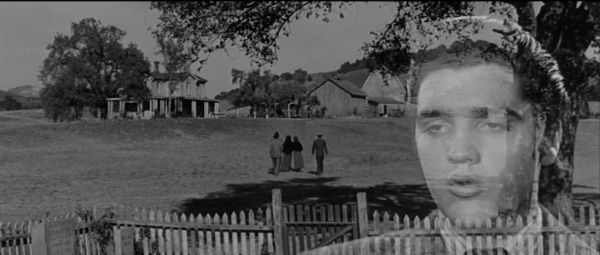
Which brings me to who were the real Reno Brothers? The following is a brief history of some of the high points of their career.
Many areas of southern Indiana during the Civil War were loyal to the Confederate States of America. Some of these loyalists were called "Cooperheads" and had voted as Democrats, being opposed to the Civil War. It was not ever confirmed if the Reno Brothers belonged to this group. Although some historians believe they were initially.
What was fact is that Franklin (Frank), John and possibly Simeon (Slim) were "Bounty Jumpers", or men who enlisted in either the Union or Confederate armies to collect money for their enlistment. Then "Jump" to another enlistment area under a different name. In the case of the three Reno's historical records indicate clearly they deserted the Union Army, and returned under false names collecting more money. The three never served and it is believed they did the same with the Confederate side.
While the fourth William (Bill) had gone AWOL from the Union army, but returned to serve out his enlistment. There was a fifth brother Clinton known as "Honest Clint", because he stayed home to take care of the farm and never was part of any crimes the other four committed. Additionally the brothers did have a sister named Laura.
John and Frank formed a gang with other "Bounty Jumpers" and began a crime spree robbing Post Offices, banks and people they encountered. In 1864 Frank and John were joined by Slim and Bill. At the start of the year Frank along with a Grant Wilson and a man named Dixon robbed a United States Post Office, were arrested for the crime, but released on bond. Wilson agreed to turn evidence on his fellow robbers, but was murdered by persons unknown. Frank was acquitted and Dixon just disappeared.
On the left is Frank Reno and on the right John Reno. I could not locate any photos of the other brothers, or their sister Laura.


On November 17, 1864 members of the Reno gang raided the Davis County Courthouse in Gattatin, Missouri. The take was $23,618 dollars in both cash and treasury bonds. However, John Reno was identified and on December 4, 1864 he was arrested. What he either did, or were he was being held during the four years the followed I could not confirm. However, on January 18, 1868 he was sentenced for the robbery to 25 years in prison. He would die in his home in Indiana on January 31, 1895.
With John captured Frank took over the leadership of the small group of outlaws in 1864. After the Civil War ended the Reno Gang became the first "Brotherhood of Outlaws" on record and grew in size and daring. They are credited with the first three peace time train robberies.
However, they were now under the investigative eyes of Alan Pinkerston's "Pinkerton National Detective Agency". While the gang continued to commit robberies in both the United States and Canada.
In 1868 Frank, William and Simeon were captured attempting to rob a train that instead of passengers was full of Pinkerton men in a set up. While in a jail on December 12, 1868 a group of 100 scarlet hooded vigilantes broke into the jail and the three Reno Brothers were lynched. The brothers bodies were turned over to their sister Laura and Franklin's wife Sarah.
During 1868 another gang of outlaws was formed and as a result the Reno Brothers became forgotten to history as the James-Younger Gang became legendary following the pattern the Reno's had established.

Above Jesse and Frank James
FRIENDLY PERSUASION AND SHENADOAH
Hollywood turned to the cost of the Civil War on average American families in two excellent motion pictures. The first was from director William "Billy" Wyler and starred Gary Cooper, Dorothy McGurie and Anthony Perkins. "The Friendly Persuasion" was released on November 25, 1956.

The picture is set in Jennings County, Indiana in 1862 just after the Civil War began. The film centers on the lives of a Quaker Family who are faced with many choices including what to do when Confederate troops "Invade" and loot their farm.
The head of the family is Jess Birdwell, Cooper, whose Quaker religion conflicts was his love of music and horse racing. While his wife Eliza, McGuire, is very religious and a minister in their small Quaker Church. Her beliefs are tested when their son Josh, Perkins, debates going against their Quaker faith and joining the local militia to defend their county and state against the Confederacy. Then her daughter Mattie, Phyllis Love, falls in love with a Union Officer Gard Jordon, Peter Mark Richmond, who is not a Quaker. Adding to her tribulations is an ongoing comic private war between her youngest child "Little Jess", Richard Eyer, and a pet goose.
The original pacifistic screenplay for the film was by Michael Wilson, but in 1951 he ran afoul of the House Committee on UnAmerican Activities and was "Blacklisted" by the Motion Picture Industry. Wilson left the United States to work in England and co-wrote the screenplays for the Oscar Winning "The Bridge on the River Kwai" and "Lawrence of Arabia". The final screenplay for "Friendly Persuasion" was nominated for an Oscar, but Michael Wilson was not mentioned as he was "Blacklisted" and William Wyler got full credit.
The picture originally was to be directed by Frank Capra, but after Wilson's Blacklisting he dropped from the project. In a February 2002 article film historian Joseph McBride noted:
.jpg)
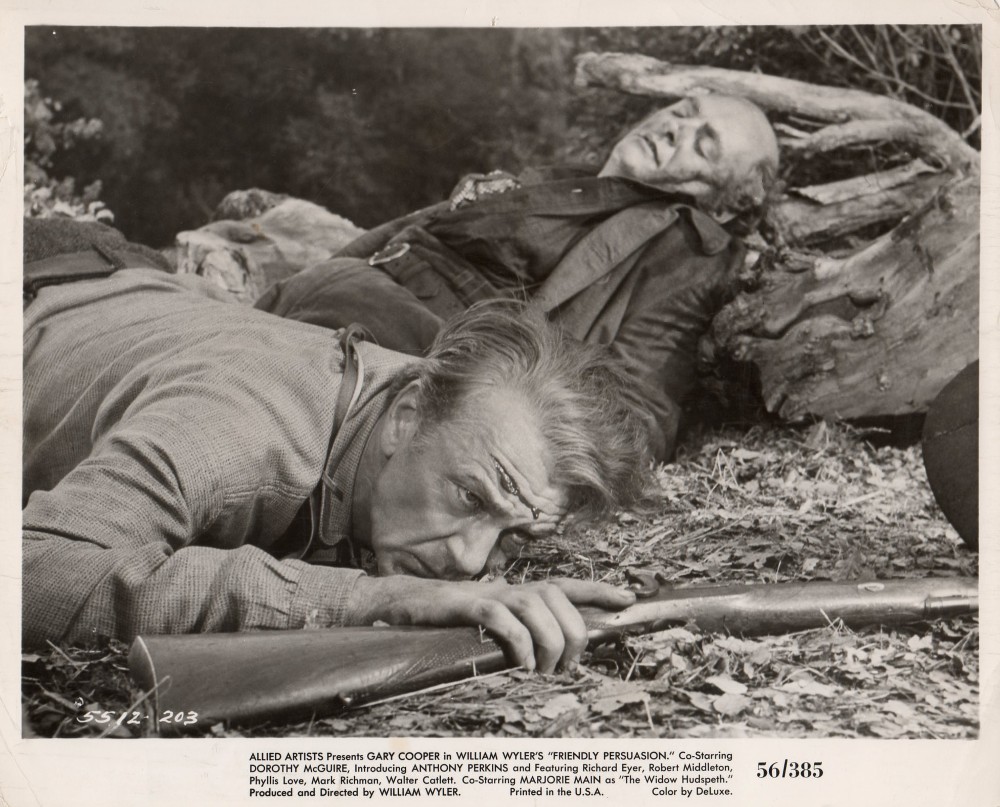
This Cold War/Civil War film was given to Soviet Premier Mikhail Gorbachev by President Ronald Reagan as an illustration of the need for peoples on opposite sides to find away to resolve their differences. Reagan was referring to the fact that Jess Birdwell's friend Sam Jordon is bushwhacked by a Confederate soldier, above, and even in anger. The Quaker decides not to kill the other man and lets him go.
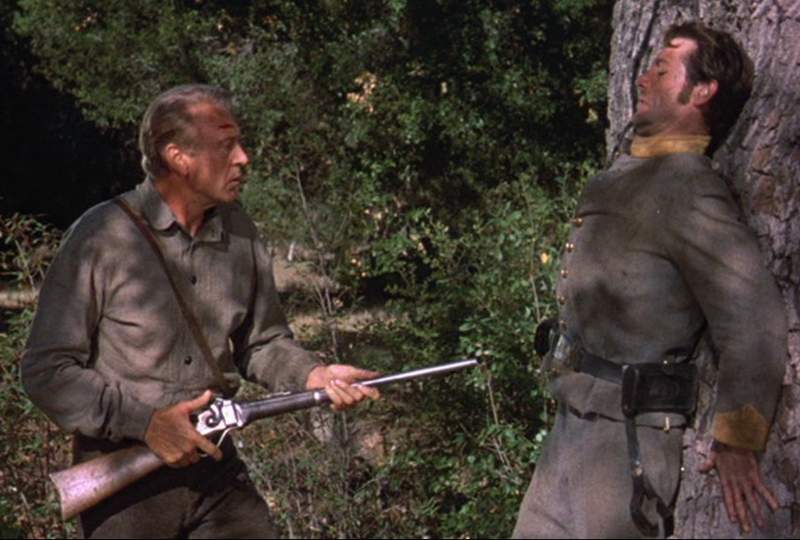
The Cold War and McCarthyism is found in many features of the first half of the 1950's. Gary Cooper and Grace Kelly starring in 1952's "High Noon" was a subtle attack on both. It was also written by the soon to be "Blacklisted" Carl Foreman. Who would also go to England and write such films as "The Guns of Navarone" and the initial screenplay also with Michael Wilson for "The Bridge on the River Kwai". As in both films Foreman's name never appeared on the original American releases.
Frank Sinatra made a very forgotten 1956 Western, his first, "Johnny Concho" which contains similar hidden political elements as "High Noon". Should my reader be interested in this period of American history. My article "Guy Endore: Black Listing and Communism in the Motion Picture Industry" can be read at:
http://www.bewaretheblog.com/2015/12/guy-endore-communism-in-motion-picture.html
On June 3, 1965 James Stewart starred in "Shenandoah".
IF "Friendly Persuasion" reflected Cold War American views. "Shenandoah" reflected the growing anti-Vietnam War sentiment in America.
The setting is 1864 Virginia and widower Charlie Anderson, Stewart, runs the family farm with his six sons, daughter and daughter-in-law and they become a microcosm of America in the 1960's reflected as if in the 1860's.
Charlies son's are:
Glenn Corbett as Jacob
Patrick Wayne as James
Charles Robinson as Nathan
James McMullen as John
Tim McIntire as Henry
Philip Alford plays the youngest. Always referred to as "Boy" (He's 16 years old)
Rosemary Forsyth is daughter Jennie
Katherine Ross is daughter-in-law Ann the wife of James.
Doug McClure is a Confederate Officer who is courting Jennie.
The family have no slaves and Charlie is against slavery. A couple of the boys want to join the war, but Charlie tells them let the war come to them first. Ann and James are expecting their first child and Charlie gives his permission for Jennie to marry Sam. Thus the story to follow is set up for the audience.
The audience sees Jennie and Sam married and as the wedding party leaves the church. A rider comes up setting in motion the first event changing Charlie's life as Sam goes off to war. This is followed by Ann going into labor and delivering a baby girl named Martha after James' mother.
"Boy" and a negro friend, Gabriel, are out fishing and he finds an old rebel cap. A Union patrol comes along and they arrest him as a rebel.

Charlie goes looking for "Boy" with his other sons except for James and Jennie. James needs to remain at the farm with Ann and their daughter. Charlie and the rest of the family come upon a Union camp. The officer in charge tells him there are no Confederate Prisoners there, but as he also has a 16 year old boy. He is sympathetic and tells Charlie were there is a train loading with prisoners to go north.
At the train the Union officer says he has a schedule to keep and won't let Charlie look for his son. Charlie leaves and sets up a roadblock for the train. "Boy" isn't there, but Jennie sees Sam. Charlie tells the prisoners to burn the train and go home.
"Boy" has been taken to a different camp and with some other Confederate soldiers escapes. There is a skirmish with a Union Patrol and the others are killed. While "Boy" is shot in the leg. A Union soldier comes up to kill him and he turns out to be Gabriel. He hides "Boy" in the bushes until the battle is completed.
Back at the farm some scavengers raid it. They kill James and then rape and kill Ann. Giving up hope of ever seeing his youngest son Charlie heads for home. Charlie and his family come across a Confederate camp and a young sentry, surprised, panics, shoots and kills Jacob. Charlie blinded with rage goes for the sentry and then stops. He asks him how old he is and the sentry replies sixteen. Charlie tells the boy he's not going to kill him and wants him to grow old, have many sons and know whats it's like to loose one in war.
Upon returning to their home. The local doctor tells the family what happened and that the baby, Martha, is still alive. The following day at breakfast Charlie starts his normal family prayer, but stops. Goes outside to visit the graves of his wife Martha, James, Ann and Jacob. He hears church bells realizing it is Sunday and takes his remaining family to the church. As they sit listening to the Minister "Boy" hobbles in on a crutch.
THE BIRTH OF A NATION (THE CLANSMAN)
Any look at Hollywood motion pictures about the Civil War Era MUST INCLUDE the 1915 feature film "The Birth of a Nation".
Released on February 8, 1915 Produced, Written and Directed by D.W. Griffith "The Birth Of A Nation" IS a Southerners Revisionist dream of the Civil War and it's aftermath. Based upon Thomas F. Dixon, Jr's "The Clansman: A Historical Romance of the Ku Klux Klan".
Griffith was a great motion picture innovator, but having been born in Oldham County, Kentucky ten years after the Civil War ended. He was raised with strong southern sympathies, What the film looked like on release is really unknown today, because Griffith kept re-editing it. Not to mention distributors for certain areas of the United States modifying the picture be fit for viewing in that part of the country. What is known is that the film was probably 193 minutes in length when originally shown in 1915 and became as short as 133 minutes. The original release had a prologue and three acts covering the Civil War and Reconstruction.
There were six screen credited cast members including Lillian Gish as Elsie Stoneman, Mae Marsh as Flora Cameron, Henry B. Waithall as Benjamin Cameron and Elmer Clifton as Phil Stoneman, D.W. Griffith regular Miriam Cooper portrayed Margaret Cameron. Cooper's husband Raul Walsh did not receive on screen credit in the role of John Wilkes Booth, but went on to be one of the great film directors. For the 1930 70 mm western motion picture "The Big Trail". Walsh cast a prop boy/extra in his first starring role, but didn't like the new actor's real name for the marquee and changed it to John Wayne. Another non-screen credited role in "The Birth of a Nation" went to Elmo Lincoln as a slave auctioneer. Lincoln has the distinction of being the first motion picture Tarzan in three motion pictures starting in 1918.
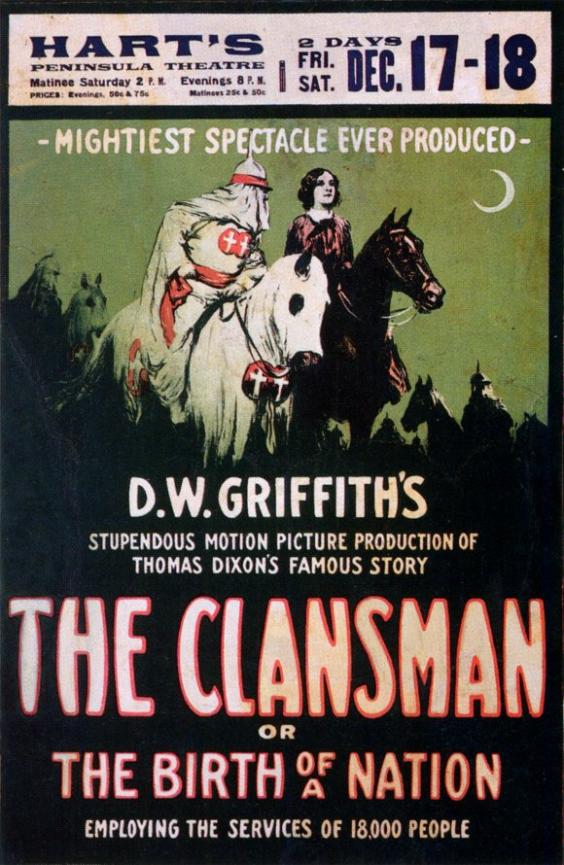
The Basic Plot:
We meet two families one from the North, the Stoneman's, and one from the South, the Cameron's. Young men from both families join their respective armies and fight in the war. There are deaths to both families and then later a black militia captures the Cameron women and the Confederates ride to their rescue.
In the following scene the black militia are obvious white actors in blackface. White's have the main roles in Griffith's motion picture and groupings like this are interspersed with real African-American extra's of 1914. The year the picture was actually filmed.

Yep, Elvis Presley in his first motion picture "Love Me Tender".
The motion picture starred Richard Egan as Vance Reno and Debra Paget as Cathy Reno. William Campbell was Brett Reno and James Drury was Ray Reno.
The Three older Reno Brothers and some other Confederate soldiers attack a Union Payroll Train. They take the payroll only to discover the war is over, but instead of returning the money they keep it. Clint has remained at home during the war to take care of the farm and their mother.
When the three brothers return home Vance finds Cathy now married to Clint. He had been reported killed in action and over the time the two married. However, it is obvious that she still loves him, but will remain faithful to Clint.
Break from the film's story line:
The motion picture was planned as a straight acting role for Elvis, but Colonel Tom Parker, his manager, thought otherwise. As this is an Elvis Presley movie. He was expected to sing by the thousands of girls in and out of the United States that would go to it. So there were four songs performed including: "Love Me Tender", "Let Me", "Poor Boy" and We're Gonna Move".
At a town social Elvis sings "Let Me".
Back to the plot:
Vance has honor and wishes both Cathy and Clint happiness. However, Clint becomes jealous and irrationally thinks otherwise of Vance and his wife. When Vance, who has the stolen money, wants to return it. Three of the other payroll robbers show up and want their share as originally planned. One of them, Mike Gavin, played by Neville Brand, seeing the tension between Clint and Vance uses it to get the youngest Reno Brother to help him.

There is a shoot out between the three Reno's, Gavin and the two other ex-Confederate train robbers. Clint is with them, but finally realizes what a fool he has been about Cathy and Vance. However, when he turns on Gavin he is shot.
The film ends with the Reno brothers returning the money, being pardoned, but along with Cathy and their mother burying Clint. Over the funeral Clint's ghost is seen once again singing "Love Me Tender" and the girls in the audience, with me at the Van Nuys Theater in Los Angeles that opening weekend, were crying their eyes out.

Which brings me to who were the real Reno Brothers? The following is a brief history of some of the high points of their career.
Many areas of southern Indiana during the Civil War were loyal to the Confederate States of America. Some of these loyalists were called "Cooperheads" and had voted as Democrats, being opposed to the Civil War. It was not ever confirmed if the Reno Brothers belonged to this group. Although some historians believe they were initially.
What was fact is that Franklin (Frank), John and possibly Simeon (Slim) were "Bounty Jumpers", or men who enlisted in either the Union or Confederate armies to collect money for their enlistment. Then "Jump" to another enlistment area under a different name. In the case of the three Reno's historical records indicate clearly they deserted the Union Army, and returned under false names collecting more money. The three never served and it is believed they did the same with the Confederate side.
While the fourth William (Bill) had gone AWOL from the Union army, but returned to serve out his enlistment. There was a fifth brother Clinton known as "Honest Clint", because he stayed home to take care of the farm and never was part of any crimes the other four committed. Additionally the brothers did have a sister named Laura.
John and Frank formed a gang with other "Bounty Jumpers" and began a crime spree robbing Post Offices, banks and people they encountered. In 1864 Frank and John were joined by Slim and Bill. At the start of the year Frank along with a Grant Wilson and a man named Dixon robbed a United States Post Office, were arrested for the crime, but released on bond. Wilson agreed to turn evidence on his fellow robbers, but was murdered by persons unknown. Frank was acquitted and Dixon just disappeared.
On the left is Frank Reno and on the right John Reno. I could not locate any photos of the other brothers, or their sister Laura.


On November 17, 1864 members of the Reno gang raided the Davis County Courthouse in Gattatin, Missouri. The take was $23,618 dollars in both cash and treasury bonds. However, John Reno was identified and on December 4, 1864 he was arrested. What he either did, or were he was being held during the four years the followed I could not confirm. However, on January 18, 1868 he was sentenced for the robbery to 25 years in prison. He would die in his home in Indiana on January 31, 1895.
With John captured Frank took over the leadership of the small group of outlaws in 1864. After the Civil War ended the Reno Gang became the first "Brotherhood of Outlaws" on record and grew in size and daring. They are credited with the first three peace time train robberies.
However, they were now under the investigative eyes of Alan Pinkerston's "Pinkerton National Detective Agency". While the gang continued to commit robberies in both the United States and Canada.
In 1868 Frank, William and Simeon were captured attempting to rob a train that instead of passengers was full of Pinkerton men in a set up. While in a jail on December 12, 1868 a group of 100 scarlet hooded vigilantes broke into the jail and the three Reno Brothers were lynched. The brothers bodies were turned over to their sister Laura and Franklin's wife Sarah.
During 1868 another gang of outlaws was formed and as a result the Reno Brothers became forgotten to history as the James-Younger Gang became legendary following the pattern the Reno's had established.

Above Jesse and Frank James
FRIENDLY PERSUASION AND SHENADOAH
Hollywood turned to the cost of the Civil War on average American families in two excellent motion pictures. The first was from director William "Billy" Wyler and starred Gary Cooper, Dorothy McGurie and Anthony Perkins. "The Friendly Persuasion" was released on November 25, 1956.

The picture is set in Jennings County, Indiana in 1862 just after the Civil War began. The film centers on the lives of a Quaker Family who are faced with many choices including what to do when Confederate troops "Invade" and loot their farm.
The head of the family is Jess Birdwell, Cooper, whose Quaker religion conflicts was his love of music and horse racing. While his wife Eliza, McGuire, is very religious and a minister in their small Quaker Church. Her beliefs are tested when their son Josh, Perkins, debates going against their Quaker faith and joining the local militia to defend their county and state against the Confederacy. Then her daughter Mattie, Phyllis Love, falls in love with a Union Officer Gard Jordon, Peter Mark Richmond, who is not a Quaker. Adding to her tribulations is an ongoing comic private war between her youngest child "Little Jess", Richard Eyer, and a pet goose.
The original pacifistic screenplay for the film was by Michael Wilson, but in 1951 he ran afoul of the House Committee on UnAmerican Activities and was "Blacklisted" by the Motion Picture Industry. Wilson left the United States to work in England and co-wrote the screenplays for the Oscar Winning "The Bridge on the River Kwai" and "Lawrence of Arabia". The final screenplay for "Friendly Persuasion" was nominated for an Oscar, but Michael Wilson was not mentioned as he was "Blacklisted" and William Wyler got full credit.
The picture originally was to be directed by Frank Capra, but after Wilson's Blacklisting he dropped from the project. In a February 2002 article film historian Joseph McBride noted:
What happened to Wilson's pacifist script after Capra dropped it, reflected the political climate of the Cold War. When William Wyler directed the film for Allied Artists in 1956 as Friendly Persuasion., he had the story changed to make the Quaker youth (Portrayed by Anthony Perkins) become a killer.
.jpg)

This Cold War/Civil War film was given to Soviet Premier Mikhail Gorbachev by President Ronald Reagan as an illustration of the need for peoples on opposite sides to find away to resolve their differences. Reagan was referring to the fact that Jess Birdwell's friend Sam Jordon is bushwhacked by a Confederate soldier, above, and even in anger. The Quaker decides not to kill the other man and lets him go.

The Cold War and McCarthyism is found in many features of the first half of the 1950's. Gary Cooper and Grace Kelly starring in 1952's "High Noon" was a subtle attack on both. It was also written by the soon to be "Blacklisted" Carl Foreman. Who would also go to England and write such films as "The Guns of Navarone" and the initial screenplay also with Michael Wilson for "The Bridge on the River Kwai". As in both films Foreman's name never appeared on the original American releases.
Frank Sinatra made a very forgotten 1956 Western, his first, "Johnny Concho" which contains similar hidden political elements as "High Noon". Should my reader be interested in this period of American history. My article "Guy Endore: Black Listing and Communism in the Motion Picture Industry" can be read at:
http://www.bewaretheblog.com/2015/12/guy-endore-communism-in-motion-picture.html
On June 3, 1965 James Stewart starred in "Shenandoah".
IF "Friendly Persuasion" reflected Cold War American views. "Shenandoah" reflected the growing anti-Vietnam War sentiment in America.
The setting is 1864 Virginia and widower Charlie Anderson, Stewart, runs the family farm with his six sons, daughter and daughter-in-law and they become a microcosm of America in the 1960's reflected as if in the 1860's.
Charlies son's are:
Glenn Corbett as Jacob
Patrick Wayne as James
Charles Robinson as Nathan
James McMullen as John
Tim McIntire as Henry
Philip Alford plays the youngest. Always referred to as "Boy" (He's 16 years old)
Rosemary Forsyth is daughter Jennie
Katherine Ross is daughter-in-law Ann the wife of James.
Doug McClure is a Confederate Officer who is courting Jennie.
The family have no slaves and Charlie is against slavery. A couple of the boys want to join the war, but Charlie tells them let the war come to them first. Ann and James are expecting their first child and Charlie gives his permission for Jennie to marry Sam. Thus the story to follow is set up for the audience.
The audience sees Jennie and Sam married and as the wedding party leaves the church. A rider comes up setting in motion the first event changing Charlie's life as Sam goes off to war. This is followed by Ann going into labor and delivering a baby girl named Martha after James' mother.
"Boy" and a negro friend, Gabriel, are out fishing and he finds an old rebel cap. A Union patrol comes along and they arrest him as a rebel.

Charlie goes looking for "Boy" with his other sons except for James and Jennie. James needs to remain at the farm with Ann and their daughter. Charlie and the rest of the family come upon a Union camp. The officer in charge tells him there are no Confederate Prisoners there, but as he also has a 16 year old boy. He is sympathetic and tells Charlie were there is a train loading with prisoners to go north.
At the train the Union officer says he has a schedule to keep and won't let Charlie look for his son. Charlie leaves and sets up a roadblock for the train. "Boy" isn't there, but Jennie sees Sam. Charlie tells the prisoners to burn the train and go home.
"Boy" has been taken to a different camp and with some other Confederate soldiers escapes. There is a skirmish with a Union Patrol and the others are killed. While "Boy" is shot in the leg. A Union soldier comes up to kill him and he turns out to be Gabriel. He hides "Boy" in the bushes until the battle is completed.
Back at the farm some scavengers raid it. They kill James and then rape and kill Ann. Giving up hope of ever seeing his youngest son Charlie heads for home. Charlie and his family come across a Confederate camp and a young sentry, surprised, panics, shoots and kills Jacob. Charlie blinded with rage goes for the sentry and then stops. He asks him how old he is and the sentry replies sixteen. Charlie tells the boy he's not going to kill him and wants him to grow old, have many sons and know whats it's like to loose one in war.
Upon returning to their home. The local doctor tells the family what happened and that the baby, Martha, is still alive. The following day at breakfast Charlie starts his normal family prayer, but stops. Goes outside to visit the graves of his wife Martha, James, Ann and Jacob. He hears church bells realizing it is Sunday and takes his remaining family to the church. As they sit listening to the Minister "Boy" hobbles in on a crutch.
THE BIRTH OF A NATION (THE CLANSMAN)
Any look at Hollywood motion pictures about the Civil War Era MUST INCLUDE the 1915 feature film "The Birth of a Nation".
Released on February 8, 1915 Produced, Written and Directed by D.W. Griffith "The Birth Of A Nation" IS a Southerners Revisionist dream of the Civil War and it's aftermath. Based upon Thomas F. Dixon, Jr's "The Clansman: A Historical Romance of the Ku Klux Klan".
Griffith was a great motion picture innovator, but having been born in Oldham County, Kentucky ten years after the Civil War ended. He was raised with strong southern sympathies, What the film looked like on release is really unknown today, because Griffith kept re-editing it. Not to mention distributors for certain areas of the United States modifying the picture be fit for viewing in that part of the country. What is known is that the film was probably 193 minutes in length when originally shown in 1915 and became as short as 133 minutes. The original release had a prologue and three acts covering the Civil War and Reconstruction.
There were six screen credited cast members including Lillian Gish as Elsie Stoneman, Mae Marsh as Flora Cameron, Henry B. Waithall as Benjamin Cameron and Elmer Clifton as Phil Stoneman, D.W. Griffith regular Miriam Cooper portrayed Margaret Cameron. Cooper's husband Raul Walsh did not receive on screen credit in the role of John Wilkes Booth, but went on to be one of the great film directors. For the 1930 70 mm western motion picture "The Big Trail". Walsh cast a prop boy/extra in his first starring role, but didn't like the new actor's real name for the marquee and changed it to John Wayne. Another non-screen credited role in "The Birth of a Nation" went to Elmo Lincoln as a slave auctioneer. Lincoln has the distinction of being the first motion picture Tarzan in three motion pictures starting in 1918.

The Basic Plot:
We meet two families one from the North, the Stoneman's, and one from the South, the Cameron's. Young men from both families join their respective armies and fight in the war. There are deaths to both families and then later a black militia captures the Cameron women and the Confederates ride to their rescue.
In the following scene the black militia are obvious white actors in blackface. White's have the main roles in Griffith's motion picture and groupings like this are interspersed with real African-American extra's of 1914. The year the picture was actually filmed.
Returning to the story:
Confederate Ben Cameron is wounded and taken to a Union hospital for treatment. Only to be told he is being mended so he can be properly executed. Elise Stoneman, who is in love with Ben, takes his mother to see President Lincoln and Ben is pardoned. This is immediately followed by Lincoln's assassination, with Raul Walsh as Brooth, and this leads to the Civil War sections of the film's ending an intermission for the audience.
After the War Austin Stoneman, Elise's and Phil's father, played by Ralph Lewis, becomes the Speaker of the House of Representatives. Stoneman and other radical Republicans decide to punish the south severely and create a Northern controlled reconstruction for the Southern States. The picture now focuses on South Carolina the home of the Cameron family.
Staying with his source material. D.W. Griffith has all the slaves freed and given the right to vote as equals to their ex-White Masters. Under the ambitious Mulatto Silas Lynch, George Siegmann. we see the black's stuffing ballot boxes while many white's are refused their right to vote. Silas Lynch becomes Lieutenant Governor and starts to turn the white population into a version of slavery.
Griffith next shows the new all black State Legislature drinking, getting drunk, bringing in women while they sit in the South Carolina House Chamber. The director ads another racial stereo type by having them served and eating fried chicken at their desks.
D,W, Griffith's hero is ex-Confederate Officer Benjamin Cameron. After observing some white children pretending to be ghosts with bed sheets over their heads and scaring black children. He gets an idea and forms the Ku Klux Klan. This causes Northern Elsie to break her relationship with the Southern Ben out of loyalty to her father.
D.W. Griffith than portrays the Klan as the saviors of the South against the repression of the victorious North and Silas Lynch.
Below the Klan catches up with Walter Lord as Gus the renegade black leader.

Lynch wants to marry Elise Stoneman so he can solidify his strangle hold on South Carolina through her father. Klan spies find out about this and that Elise is being held prisoner. They gallantly come to her rescue ending Silas Lynch's hold over South Carolina.
That event leads to the following endings:
First the audience sees the double wedding of Elise to Ben and Margaret Cameron to Phil Stoneman signifying the uniting of the North and the South.
Second the audiences sees the mass of people making up the United States with a double exposed image of a giant warlike figure which fades away into Jesus Christ and the final title card:
Peace for the United States under the gentle protector-ship of the Knights of the Ku Klux Klan.
In 2016 a new version of "The Birth of a Nation" appeared on the movie screen from Producer/Writer/Director and Actor Nat Parker. He explained in an article by Soheil Razayazdl, published January 26, 2016, in "Filmmaker". Why he made a motion picture with the racially charged D.W. Griffith title:
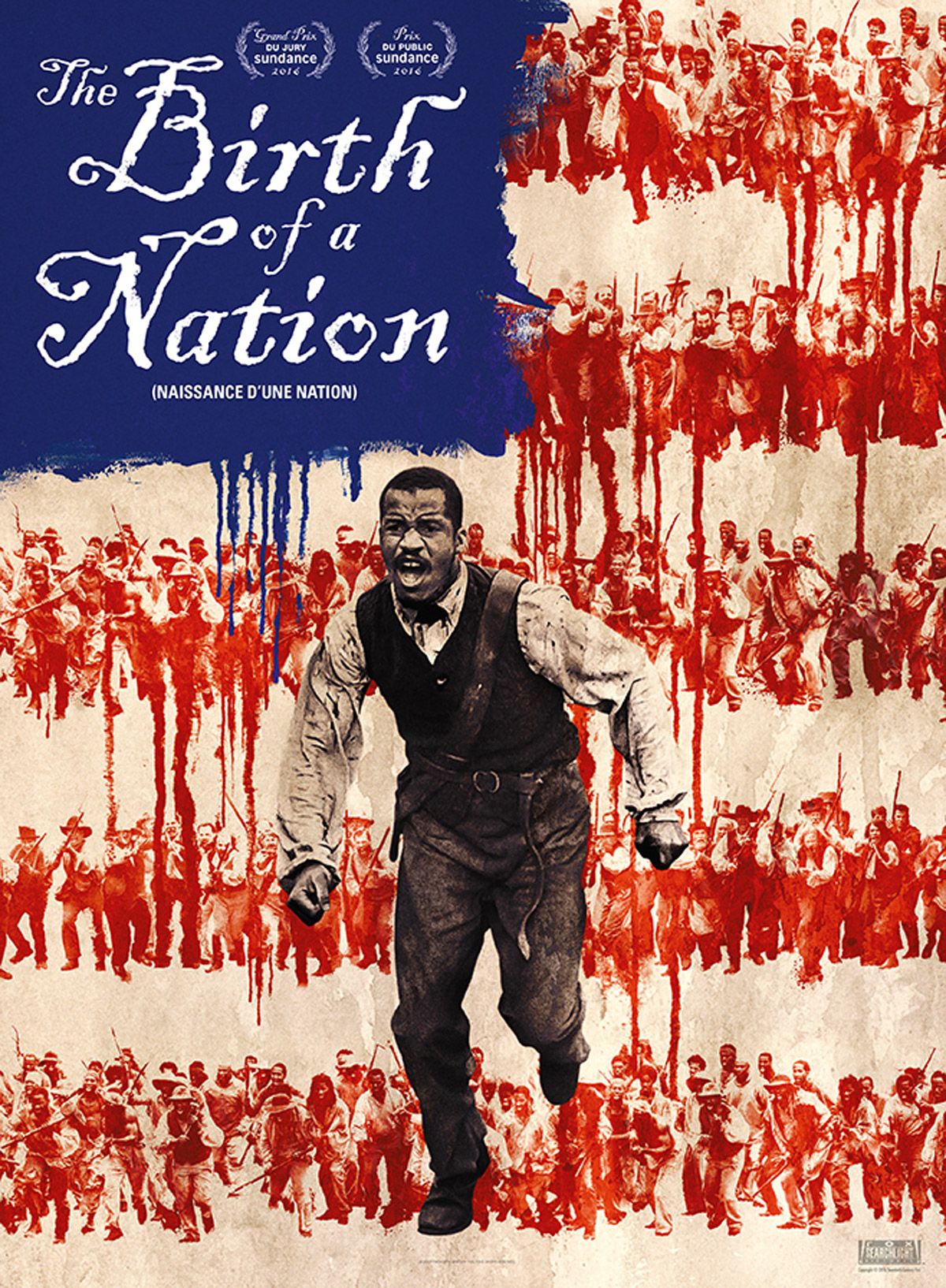
MY FINAL TWO MOTION PICTURES BOTH FEATURE HATTIE MCDANIEL
Song of the South (1946)
One month after I was born on November 12, 1946 Walt Disney released "Song of the South". The idea of Disney be accused of being a racist may sound strange to many of my readers, but that was the charge this motion picture and other works such as 1941's "Dumbo" brought out.

I am not going into detail about those charges in this article. For those who might be interested in that and the rise of the Walt Disney Studio and the fall of the Max Fleischer Studio, he created "Betty Boop" and "Popeye the Sailor". My article on their feud and this motion picture can be read at:
http://www.bewaretheblog.com/2015/04/the-great-walt-disney-max-fleischer.html
The story is very simple. The Civil War has ended and it is Reconstruction. Seven year old Johnny, Bobby Driscoll, Jim Hawkins in "Treasure Island" and the voice of "Peter Pan", has returned with his parents to his grandmother's plantation in Georgia. All seems fine until he's told his parents will be separated for awhile. His father needs to return to Atlanta as editor of a newspaper. Johnny becomes a lost soul in a women's world and will be laughed at for the clothing his mother dresses him in.
This will lead to Johnny discovering an old slave everyone calls "Uncle Remus", James Baskett, and his stories about "Br'er Rabbit, Br'er Fox and Br'er Bear.

The basic film is about a boy facing the responsibilities of growing up, friendship and love. The housekeeper "Aunt Tempy" was portrayed by Hattie McDaniel. Below Hattie McDaniel and Bobby Driscoll at the start of "Song of the South".

Johnny makes friends with two other young children of his age. One is the black slave boy Tobby, Glenn Leedy, and the other a poor white girl Ginny, Luana Patten. These are children acting like children without realizing that their "stations in life" should keep them apart. The three will have adventures as they go looking for "Br'er Rabbit's" "Laughing Place" throughout the movie. The family is reunited at the end after Johnny disobeys and cuts across a pasture with a bull in it. He is attacked chasing after "Uncle Remus" who was told to leave the plantation for filling the boy's head with unrealistic stories.
So where's the racism in the plot?
Returning to Hattie McDaniel's most un-favorite person Walter Francis White of the NAACP. He stated on the group's behalf:
The above quote can be found in Karl F. Cohen's 1997 "Forbidden Animation: Censored Cartoons and Black Listed Animators in America".
A major complaint from the time of it's release concerned the plantations "slaves" singing on their way to the fields and "Uncle Remus" singing the Academy Award winning song "Zip-A-Dee-Do-Duh". In short they were too happy to be on a Southern Plantation during the Reconstruction period.
My reader may find a DVD of this motion picture in almost every country in the World EXCEPT the United States. They are produced by the Walt Disney Company for sale overseas and in Canada and Mexico. However, the Walt Disney company has never released a complete copy of the movie for home entertainment here or aired it on their television stations, because of the controversy. Yet, the cartoon segments are available, because they do not contain the "happy" plantation workers. However, even they are subject to racial overtones in the way the characters speak and interact. There have been many petitions to release "Song of the South" in those formats. As of this writing, the last time it was brought up for consideration at a board meeting was 2010.
Show Boat
In 1926 author Edna Ferber published "Show Boat". A novel about three generations of performers on the Show Boat "Cotton Blossom". The novel looks at life along the Mississippi River during the 1880's into the 1920's. It starts a few years after Reconstruction ended. This novel, like Ferber's "Giant" about Texas and "Ice Place" about Alaska, made excellent reading, but also great sources to turn them into motion pictures. My article of Edna Ferber and her works can be found at:
http://www.bewaretheblog.com/2016/12/edna-ferber-and-hollywood.html
When it opened on Broadway, December 27, 1927, Jerome Kern and Oscar Hammerstein II had turned Edna Ferber's novel into what would become one of the most famous musicals in history. The score included "Ol'Man River", "Make Believe", "Bill" and "Can't Help Lovin' Dat Man".
However, it was the opening number "Cotton Blossom" that was deliberately written to reflect Southern prejudices by Oscar Hammerstein II. This racially explicit song underlines the tone for a tragic subplot.
As the curtain opens the audience heard the "Stevedores" and the "Gals" start singing:
The "N" word was changed in later productions to: "Colored Folk", "Darkies" and finally in most versions the opening song now starts:
.
Stevedores
Here we all work on de Mississippi
Here we all work while de white folks play,
Loadin' up boots wid de bales of cotton,
Gettin' no rest till de Judgement Day.
Gals
Drop dat bale and have some fun!
Dere's a lot o' lovin' on de levee for you
Y' work all day, y' get no fun~
We know somethin' better for a feller to do!
I agree with a December 8, 2005 blog article by Richard Keeling concerning the original lyrics and their purpose.:
On April 27, 1929 Universal Pictures released the first motion picture version of "Show Boat", but this was not the musical as it's plot went back to the original novel. It was also a silent motion picture, but changed just before release into a hybrid silent/sound film. This was the result of the public's demand for "Talkies", because of "The Jazz Singer". Sound sequences of songs were written for this motion picture, but not those by Jerome Kern and Oscar Hammerstein II. Then a few smart minds realized the audience would expect to hear the Broadway score. So Universal paid to get four Kern/Hammerstein songs and shoot film of original Broadway cast members singing in a prologue only. I am not really interested in this version, but it needed to be mentioned,
In 1936 Universal Studio's corrected their earlier error and produced what I consider to be the best of the three filmed versions of "Show Boat". This was the Kern and Hammerstein Broadway Show, but nicely adapted to motion pictures. On all the posters and lobby cards for this production Universal Studio placed the words "Version of 1936". So audiences knew this was not a re-release of the 1929 feature.

The first thing to notice about this film is the director James Whale. Whale wanted to do this musical, but he was best known for Horror. Which included 1931's "Frankenstein", 1932's "The Old Dark House, 1933's "The Invisible Man" and 1935's "The Bride of Frankenstein". Carl Laemmle Universal's owner was concerned about turning this picture over to him. He needed not have worried! As some of James Whale's black and white imagery are spot on and invoke the period directly following Reconstruction perfectly.

|
In the above still from the opening of the picture. The "Cotton Blossum" is being pushed by a paddle wheeler. This was the real way such performance boats were moved along the Mississippi into communities for shows. The "Cotton Blossum" had the actual stage, audience theater and dressing rooms for costume changes. There is no room on the paddle wheeler which might have a small salon, used for gambling on some river boats, and actual bedrooms and kitchen facilities. This is the detail James Whale went to with the 1936 production. When MGM remade the film in 1951 the "Cotton Blossum" was a paddle wheeler. Also in this opening sequence a shorten, racial words removed, version of the opening song was being sung not by just the Stevedores and Gals, but the crowd that came to see the Show Boat's arrival.
Which now brings me to the cast. Probably the greatest asset to the picture were fourth billed Paul Robeson as Joe and fifth billed Helen Morgan as Julie. She had performed the role in the original Broadway Cast and in the prologue to the 1929 film. I will speak of both singers shortly.
The two leads were Irene Dunne as Magnolia Hawks and Allan Jones as Gaylord Ravenol. The cast also included Charles Winninger as Magnolia's father Cap'n Andy Hawks and featured once again Hattie McDaniel as Joe's loving wife Queenie.

In the above photo of Dunne and Jones the character of Magnolia is 18 years of age. By the end of the picture she will have aged 40 years. Gaylord is a gambler by trade and their love is tested as he leaves Magnolia after 10 years of marriage, because his luck has changed. Ravenol feels he can't provide for his wife and little daughter. The movie follows their ups and downs, but it is the two subplots that concern me here.
As to the first subplot. I already discussed Hattie McDaniel and the 1940's Academy Awards.
So let me speak to Paul Robson.(His last name is pronounced roubsan). I will not go into detail about his life, but give you the high points. He was the third African-American to go to Rutgers and was on their football team. In 1923 he obtained his Law Degree. He stopped practicing law almost immediately, because of the racism he faced. He started singing on stage in productions. In 1927 he appeared in a revival, on Broadway, of Eugene O'Neil's "All God's Chillun Got Wings". Which moved him into elite social circles. In 1928 he first portrayed the role of "Joe" in the London Stage Production of "Showboat".
By 1937 Robson was becoming a political activist and this led to him defending the Republican Cause in the Spanish Civil War. In 1942 he appeared as narrator for a filmed documentary supportive of trade unions called "Native Land" The FBI labeled the film Communist propaganda and by Association Robson a Communist. In 1943 he became the first African-American to portray Shakespeare's "Othello"on Broadway. The rest of the roles in that production were performed by White actors.
Paul Robson was able to get a private meeting with President Harry Truman after four African-Americans were lynched for no real reason other than the color of their skin. He asked Truman to outlaw lynchings in the United States. The President refused and Robson replied the without a law African-Americans might take the law into their own hands.
Shortly after this Paul Robson was called before the California State Legislature's "Tenny Committee" and questioned about ties, claimed by the FBI, to the "Communist Party USA". Robson testified he was not a member. However, in a political move. Two organizations that the actor was involved with, on April 3, 1947, got added to the United States Attorney General's List of Subversive Organizations. By inference Paul Robson was a subversive and possibly a Communist sympathizer. In 1950 he was Black Listed by the Motion Picture Industry and left the United States. This would last through 1955.
_01.jpg)
Above the characters of Queenie and Joe may not be educated, but they are not portrayed as stereotypes either. The two have a somewhat comical relationship, but the two interact with dignity with the Cap'n Andy and his family on board the "Cotton Blossum".
There is a great scene between Queenie and Magnolia that shows how wise this women really happens to be. Magnolia is planning to do a minstrel number, which was expected on Show Boats of the period, but Queenie gets in a word or two about a white girl being in blackface.
Joe on the other hand is laid back and gets on Queenie's nerves at times, but this adds to their relationship and is anything but stereotypical. One of the two highlights of the film is when Paul Robson sings "Ol' Man River".
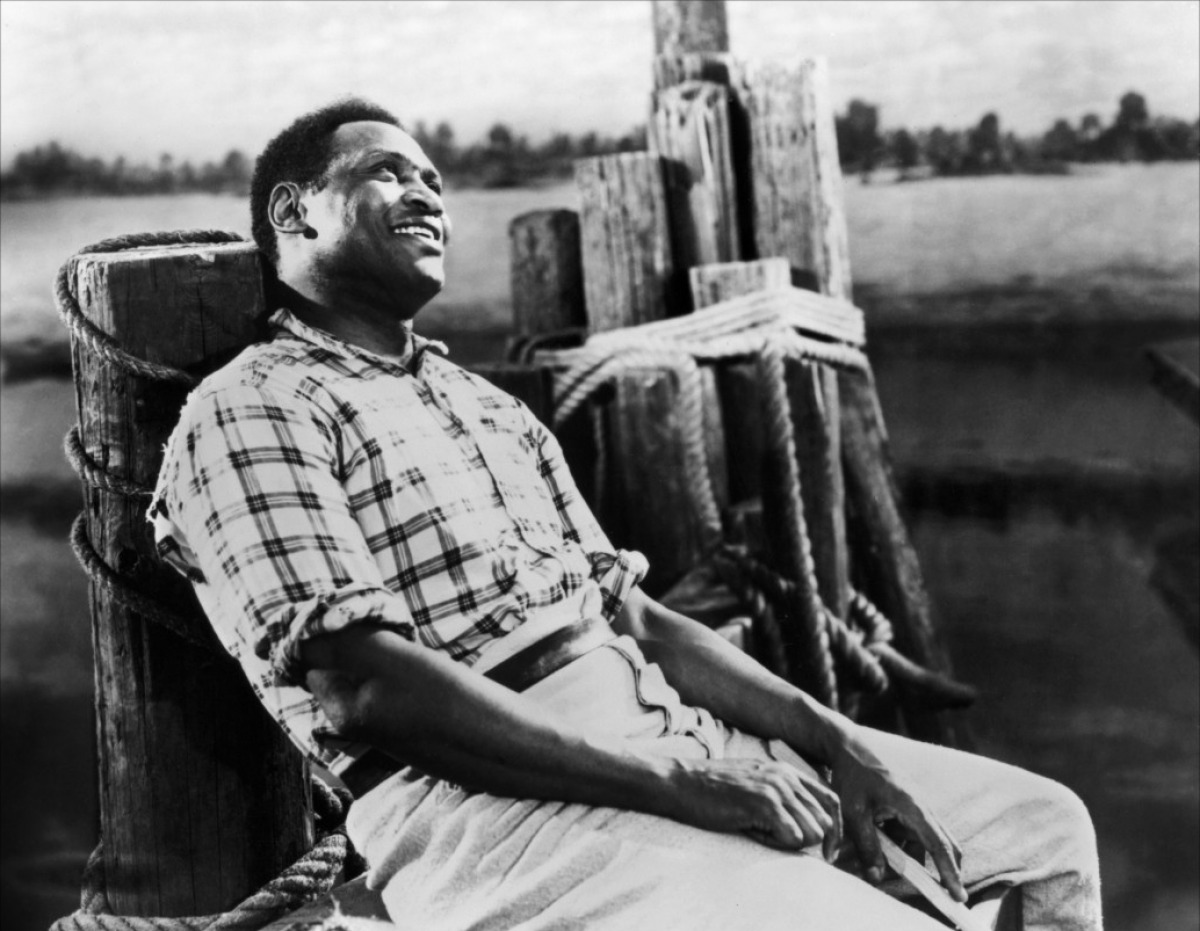

The second subplot concerns the main act on the "Cotton Blossom". That of Julie LaVerne, Helen Morgan, and Julie's husband Steve Baker portrayed by Donald Cook. Helen Morgan was a Torch Singer. Torch songs are about lost love, or a unrequited love in a sultry blues style. In the case of "Show Boat" there are two: "Bill" and "Can't Help Lovin' Dat Man". In this film both are song by Morgan with great power and the viewer can't help but listen.
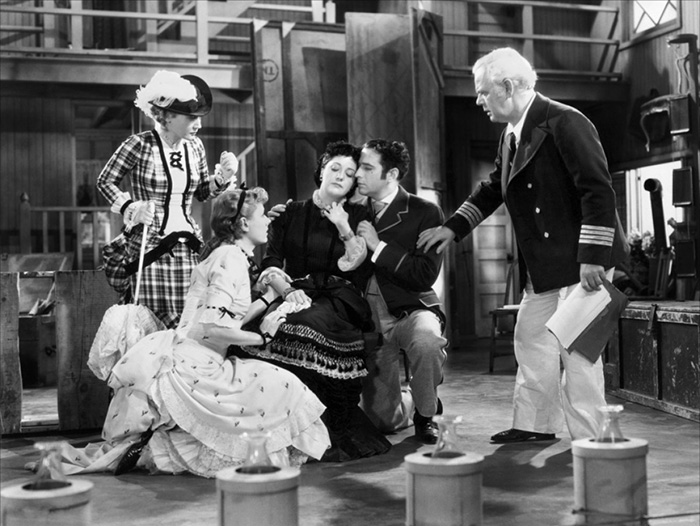
In the above still the truth about Julie LaVerne has been revealed by a local Southern Sheriff to the shock of the Hawks family. One of Julie's parents was black and she has been passing herself off a white.Under the law she is illegally married to Steve. As Julie is considered black and must leave the state, or be jailed. Steve can stay and so he takes a pocket knife and pricks her finger and his own mixing their blood. Now by law he is also black.
Later Julie is abandoned by Steve and becomes an alcoholic.

Drinking herself to death Julie sings the torch song "Bill". James Whale got a beautifully sad performance out of Helen Morgan at this point in the film. Actually, he knew that Morgan was herself an alcoholic and she put herself into the sequence. This was Morgan's last motion picture. In 1940 she appeared in a Los Angeles Revival of "Show Boat" and the following year she was dead from cirrhosis of the liver on October 9, 1941.
Confederate Ben Cameron is wounded and taken to a Union hospital for treatment. Only to be told he is being mended so he can be properly executed. Elise Stoneman, who is in love with Ben, takes his mother to see President Lincoln and Ben is pardoned. This is immediately followed by Lincoln's assassination, with Raul Walsh as Brooth, and this leads to the Civil War sections of the film's ending an intermission for the audience.
After the War Austin Stoneman, Elise's and Phil's father, played by Ralph Lewis, becomes the Speaker of the House of Representatives. Stoneman and other radical Republicans decide to punish the south severely and create a Northern controlled reconstruction for the Southern States. The picture now focuses on South Carolina the home of the Cameron family.
Staying with his source material. D.W. Griffith has all the slaves freed and given the right to vote as equals to their ex-White Masters. Under the ambitious Mulatto Silas Lynch, George Siegmann. we see the black's stuffing ballot boxes while many white's are refused their right to vote. Silas Lynch becomes Lieutenant Governor and starts to turn the white population into a version of slavery.
Griffith next shows the new all black State Legislature drinking, getting drunk, bringing in women while they sit in the South Carolina House Chamber. The director ads another racial stereo type by having them served and eating fried chicken at their desks.
D,W, Griffith's hero is ex-Confederate Officer Benjamin Cameron. After observing some white children pretending to be ghosts with bed sheets over their heads and scaring black children. He gets an idea and forms the Ku Klux Klan. This causes Northern Elsie to break her relationship with the Southern Ben out of loyalty to her father.
D.W. Griffith than portrays the Klan as the saviors of the South against the repression of the victorious North and Silas Lynch.
Below the Klan catches up with Walter Lord as Gus the renegade black leader.

Lynch wants to marry Elise Stoneman so he can solidify his strangle hold on South Carolina through her father. Klan spies find out about this and that Elise is being held prisoner. They gallantly come to her rescue ending Silas Lynch's hold over South Carolina.
That event leads to the following endings:
First the audience sees the double wedding of Elise to Ben and Margaret Cameron to Phil Stoneman signifying the uniting of the North and the South.
Second the audiences sees the mass of people making up the United States with a double exposed image of a giant warlike figure which fades away into Jesus Christ and the final title card:
Dare we dream of a golden day when the bestial War shall rule no more. But instead — the gentle Prince in the Hall of Brotherly Love in the City of Peace.
Peace for the United States under the gentle protector-ship of the Knights of the Ku Klux Klan.
In 2016 a new version of "The Birth of a Nation" appeared on the movie screen from Producer/Writer/Director and Actor Nat Parker. He explained in an article by Soheil Razayazdl, published January 26, 2016, in "Filmmaker". Why he made a motion picture with the racially charged D.W. Griffith title:
Griffith's film relied heavily on racist propaganda to evoke fear and desperation as a tool to solidify white supremacy as the lifeblood of American sustenance. Not only did this film motivate the massive resurgence of the terror group the Ku Klux Klan and the carnage exacted against people of African descent, it served as the foundation of the film industry we know today. I've reclaimed this title and re-purposed it as a tool to challenge racism and white supremacy in America, to inspire a riotous disposition toward any and all injustice in this country (and abroad) and to promote the kind of honest confrontation that will galvanize our society toward healing and sustained systemic change.

MY FINAL TWO MOTION PICTURES BOTH FEATURE HATTIE MCDANIEL
Song of the South (1946)
One month after I was born on November 12, 1946 Walt Disney released "Song of the South". The idea of Disney be accused of being a racist may sound strange to many of my readers, but that was the charge this motion picture and other works such as 1941's "Dumbo" brought out.

I am not going into detail about those charges in this article. For those who might be interested in that and the rise of the Walt Disney Studio and the fall of the Max Fleischer Studio, he created "Betty Boop" and "Popeye the Sailor". My article on their feud and this motion picture can be read at:
http://www.bewaretheblog.com/2015/04/the-great-walt-disney-max-fleischer.html
The story is very simple. The Civil War has ended and it is Reconstruction. Seven year old Johnny, Bobby Driscoll, Jim Hawkins in "Treasure Island" and the voice of "Peter Pan", has returned with his parents to his grandmother's plantation in Georgia. All seems fine until he's told his parents will be separated for awhile. His father needs to return to Atlanta as editor of a newspaper. Johnny becomes a lost soul in a women's world and will be laughed at for the clothing his mother dresses him in.
This will lead to Johnny discovering an old slave everyone calls "Uncle Remus", James Baskett, and his stories about "Br'er Rabbit, Br'er Fox and Br'er Bear.

The basic film is about a boy facing the responsibilities of growing up, friendship and love. The housekeeper "Aunt Tempy" was portrayed by Hattie McDaniel. Below Hattie McDaniel and Bobby Driscoll at the start of "Song of the South".

Johnny makes friends with two other young children of his age. One is the black slave boy Tobby, Glenn Leedy, and the other a poor white girl Ginny, Luana Patten. These are children acting like children without realizing that their "stations in life" should keep them apart. The three will have adventures as they go looking for "Br'er Rabbit's" "Laughing Place" throughout the movie. The family is reunited at the end after Johnny disobeys and cuts across a pasture with a bull in it. He is attacked chasing after "Uncle Remus" who was told to leave the plantation for filling the boy's head with unrealistic stories.
So where's the racism in the plot?
Returning to Hattie McDaniel's most un-favorite person Walter Francis White of the NAACP. He stated on the group's behalf:
The National Association for the Advancement of Colored People recognizes in "Song of the South" remarkable artistic merit in the music and in the combination of living actors and the cartoon technique. It regrets, however, that in an effort to neither offend audiences in the north or south, the production helps to perpetuate a dangerously glorified picture of slavery. Making use of the beautiful Uncle Remus folklore, "Song of the South" unfortunately gives the impression of an idyllic master-slave relationship which is a distortion of the facts
The above quote can be found in Karl F. Cohen's 1997 "Forbidden Animation: Censored Cartoons and Black Listed Animators in America".
A major complaint from the time of it's release concerned the plantations "slaves" singing on their way to the fields and "Uncle Remus" singing the Academy Award winning song "Zip-A-Dee-Do-Duh". In short they were too happy to be on a Southern Plantation during the Reconstruction period.
My reader may find a DVD of this motion picture in almost every country in the World EXCEPT the United States. They are produced by the Walt Disney Company for sale overseas and in Canada and Mexico. However, the Walt Disney company has never released a complete copy of the movie for home entertainment here or aired it on their television stations, because of the controversy. Yet, the cartoon segments are available, because they do not contain the "happy" plantation workers. However, even they are subject to racial overtones in the way the characters speak and interact. There have been many petitions to release "Song of the South" in those formats. As of this writing, the last time it was brought up for consideration at a board meeting was 2010.
Show Boat
In 1926 author Edna Ferber published "Show Boat". A novel about three generations of performers on the Show Boat "Cotton Blossom". The novel looks at life along the Mississippi River during the 1880's into the 1920's. It starts a few years after Reconstruction ended. This novel, like Ferber's "Giant" about Texas and "Ice Place" about Alaska, made excellent reading, but also great sources to turn them into motion pictures. My article of Edna Ferber and her works can be found at:
http://www.bewaretheblog.com/2016/12/edna-ferber-and-hollywood.html
When it opened on Broadway, December 27, 1927, Jerome Kern and Oscar Hammerstein II had turned Edna Ferber's novel into what would become one of the most famous musicals in history. The score included "Ol'Man River", "Make Believe", "Bill" and "Can't Help Lovin' Dat Man".
However, it was the opening number "Cotton Blossom" that was deliberately written to reflect Southern prejudices by Oscar Hammerstein II. This racially explicit song underlines the tone for a tragic subplot.
As the curtain opens the audience heard the "Stevedores" and the "Gals" start singing:
STEVEDORES
Niggers all work on de Mississippi
Niggers all work while de white folks play-
Loadin' up boats wid de bales of cotton,
Gittin' no rest till de Judgement Day.
GALS
Git yo'self a bran' new gal,
A lovin' baby who's de apple of yo' eye.
Coal black Rose or high brown Sal,
Dey all kin cook de sparrer grass an' chicken pie!
The "N" word was changed in later productions to: "Colored Folk", "Darkies" and finally in most versions the opening song now starts:
.
Stevedores
Here we all work on de Mississippi
Here we all work while de white folks play,
Loadin' up boots wid de bales of cotton,
Gettin' no rest till de Judgement Day.
Gals
Drop dat bale and have some fun!
Dere's a lot o' lovin' on de levee for you
Y' work all day, y' get no fun~
We know somethin' better for a feller to do!
I agree with a December 8, 2005 blog article by Richard Keeling concerning the original lyrics and their purpose.:
Show Boat begins with the singing of that most reprehensible word – nigger – ... [it] immediately establishes race as one of the central themes of the play. This is a protest song, more ironic than angry perhaps, but a protest nonetheless. In the singers' hands, the word nigger has a sardonic tone... in the very opening, Hammerstein has established the gulf between the races, the privilege accorded the white folks and denied the black, and a flavor of the contempt built into the very language that whites used about African Americans. This is a very effective scene.... These are not caricature roles; they are wise, if uneducated, people capable of seeing and feeling more than some of the white folk around them.
On April 27, 1929 Universal Pictures released the first motion picture version of "Show Boat", but this was not the musical as it's plot went back to the original novel. It was also a silent motion picture, but changed just before release into a hybrid silent/sound film. This was the result of the public's demand for "Talkies", because of "The Jazz Singer". Sound sequences of songs were written for this motion picture, but not those by Jerome Kern and Oscar Hammerstein II. Then a few smart minds realized the audience would expect to hear the Broadway score. So Universal paid to get four Kern/Hammerstein songs and shoot film of original Broadway cast members singing in a prologue only. I am not really interested in this version, but it needed to be mentioned,
In 1936 Universal Studio's corrected their earlier error and produced what I consider to be the best of the three filmed versions of "Show Boat". This was the Kern and Hammerstein Broadway Show, but nicely adapted to motion pictures. On all the posters and lobby cards for this production Universal Studio placed the words "Version of 1936". So audiences knew this was not a re-release of the 1929 feature.

The first thing to notice about this film is the director James Whale. Whale wanted to do this musical, but he was best known for Horror. Which included 1931's "Frankenstein", 1932's "The Old Dark House, 1933's "The Invisible Man" and 1935's "The Bride of Frankenstein". Carl Laemmle Universal's owner was concerned about turning this picture over to him. He needed not have worried! As some of James Whale's black and white imagery are spot on and invoke the period directly following Reconstruction perfectly.

|
In the above still from the opening of the picture. The "Cotton Blossum" is being pushed by a paddle wheeler. This was the real way such performance boats were moved along the Mississippi into communities for shows. The "Cotton Blossum" had the actual stage, audience theater and dressing rooms for costume changes. There is no room on the paddle wheeler which might have a small salon, used for gambling on some river boats, and actual bedrooms and kitchen facilities. This is the detail James Whale went to with the 1936 production. When MGM remade the film in 1951 the "Cotton Blossum" was a paddle wheeler. Also in this opening sequence a shorten, racial words removed, version of the opening song was being sung not by just the Stevedores and Gals, but the crowd that came to see the Show Boat's arrival.
Which now brings me to the cast. Probably the greatest asset to the picture were fourth billed Paul Robeson as Joe and fifth billed Helen Morgan as Julie. She had performed the role in the original Broadway Cast and in the prologue to the 1929 film. I will speak of both singers shortly.
The two leads were Irene Dunne as Magnolia Hawks and Allan Jones as Gaylord Ravenol. The cast also included Charles Winninger as Magnolia's father Cap'n Andy Hawks and featured once again Hattie McDaniel as Joe's loving wife Queenie.

In the above photo of Dunne and Jones the character of Magnolia is 18 years of age. By the end of the picture she will have aged 40 years. Gaylord is a gambler by trade and their love is tested as he leaves Magnolia after 10 years of marriage, because his luck has changed. Ravenol feels he can't provide for his wife and little daughter. The movie follows their ups and downs, but it is the two subplots that concern me here.
As to the first subplot. I already discussed Hattie McDaniel and the 1940's Academy Awards.
So let me speak to Paul Robson.(His last name is pronounced roubsan). I will not go into detail about his life, but give you the high points. He was the third African-American to go to Rutgers and was on their football team. In 1923 he obtained his Law Degree. He stopped practicing law almost immediately, because of the racism he faced. He started singing on stage in productions. In 1927 he appeared in a revival, on Broadway, of Eugene O'Neil's "All God's Chillun Got Wings". Which moved him into elite social circles. In 1928 he first portrayed the role of "Joe" in the London Stage Production of "Showboat".
By 1937 Robson was becoming a political activist and this led to him defending the Republican Cause in the Spanish Civil War. In 1942 he appeared as narrator for a filmed documentary supportive of trade unions called "Native Land" The FBI labeled the film Communist propaganda and by Association Robson a Communist. In 1943 he became the first African-American to portray Shakespeare's "Othello"on Broadway. The rest of the roles in that production were performed by White actors.
Paul Robson was able to get a private meeting with President Harry Truman after four African-Americans were lynched for no real reason other than the color of their skin. He asked Truman to outlaw lynchings in the United States. The President refused and Robson replied the without a law African-Americans might take the law into their own hands.
Shortly after this Paul Robson was called before the California State Legislature's "Tenny Committee" and questioned about ties, claimed by the FBI, to the "Communist Party USA". Robson testified he was not a member. However, in a political move. Two organizations that the actor was involved with, on April 3, 1947, got added to the United States Attorney General's List of Subversive Organizations. By inference Paul Robson was a subversive and possibly a Communist sympathizer. In 1950 he was Black Listed by the Motion Picture Industry and left the United States. This would last through 1955.
_01.jpg)
Above the characters of Queenie and Joe may not be educated, but they are not portrayed as stereotypes either. The two have a somewhat comical relationship, but the two interact with dignity with the Cap'n Andy and his family on board the "Cotton Blossum".
There is a great scene between Queenie and Magnolia that shows how wise this women really happens to be. Magnolia is planning to do a minstrel number, which was expected on Show Boats of the period, but Queenie gets in a word or two about a white girl being in blackface.
Joe on the other hand is laid back and gets on Queenie's nerves at times, but this adds to their relationship and is anything but stereotypical. One of the two highlights of the film is when Paul Robson sings "Ol' Man River".


The second subplot concerns the main act on the "Cotton Blossom". That of Julie LaVerne, Helen Morgan, and Julie's husband Steve Baker portrayed by Donald Cook. Helen Morgan was a Torch Singer. Torch songs are about lost love, or a unrequited love in a sultry blues style. In the case of "Show Boat" there are two: "Bill" and "Can't Help Lovin' Dat Man". In this film both are song by Morgan with great power and the viewer can't help but listen.

In the above still the truth about Julie LaVerne has been revealed by a local Southern Sheriff to the shock of the Hawks family. One of Julie's parents was black and she has been passing herself off a white.Under the law she is illegally married to Steve. As Julie is considered black and must leave the state, or be jailed. Steve can stay and so he takes a pocket knife and pricks her finger and his own mixing their blood. Now by law he is also black.
Later Julie is abandoned by Steve and becomes an alcoholic.

Drinking herself to death Julie sings the torch song "Bill". James Whale got a beautifully sad performance out of Helen Morgan at this point in the film. Actually, he knew that Morgan was herself an alcoholic and she put herself into the sequence. This was Morgan's last motion picture. In 1940 she appeared in a Los Angeles Revival of "Show Boat" and the following year she was dead from cirrhosis of the liver on October 9, 1941.
Long ol' river keeps hearing dat song.
You an' me, we sweat an' strain,
Body all achin an' racked wid pain.
Tote dat barge!
Lif' dat bale!
Git a little drunk
An' you land in jail.
Ah, gits weary
An' sick of tryin'
Ah'm tired of livin'
An' skeered of dyin',
But ol' man river,
He jes'keeps rollin' along!


